Steam train from Carcross to Bennett and back
June 29 was an amazing day, riding behind the White Pass & Yukon Route’s beloved 1947 Baldwin steam locomotive #73 to Bennett and back. I’m still not clear on how this all played out, but 9 days prior I had received an email from a friend at the WP&YR, letting me know about this last-minute excursion, with very limited seating. I forwarded it to some friends, and a couple of days later posted a brief message on my Facebook page: “Whitehorse rail fans – there’s a Steam(!!) train excursion from Carcross to Bennett and back next Saturday (June 29). Very limited seating, $75 per person.”
We headed for Carcross at 10:45 to give lots of time to park and find a good spot to board the train, but almost didn’t make it to Carcross at all. I asked Cathy to drive, and went to sleep. I didn’t see the start of what happened, but the dashcam in the Jeep did. There was a grizzly beside the road…
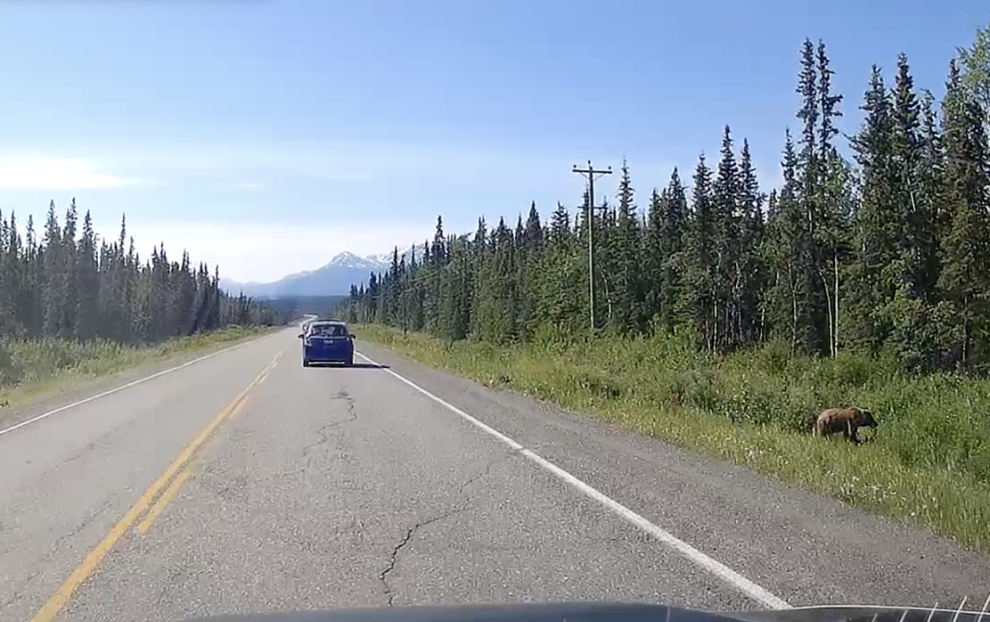
…and the car ahead of us (Yukon plate EEP) decided at the last second to pull into a driveway on the opposite side of the road to go back for a look. I was woken up by yelling and hard braking. A car was passing several of us at a very high rate of speed (120-130 km/h, perhaps higher), and barely missed hitting the person in front of us – he started to turn into the driveway, then saw the car and quit turning. Only by a fraction of a second did they miss getting hit on the side – there almost certainly would have been fatalities, and we may well have been involved. I posted a 9-second video at Youtube.
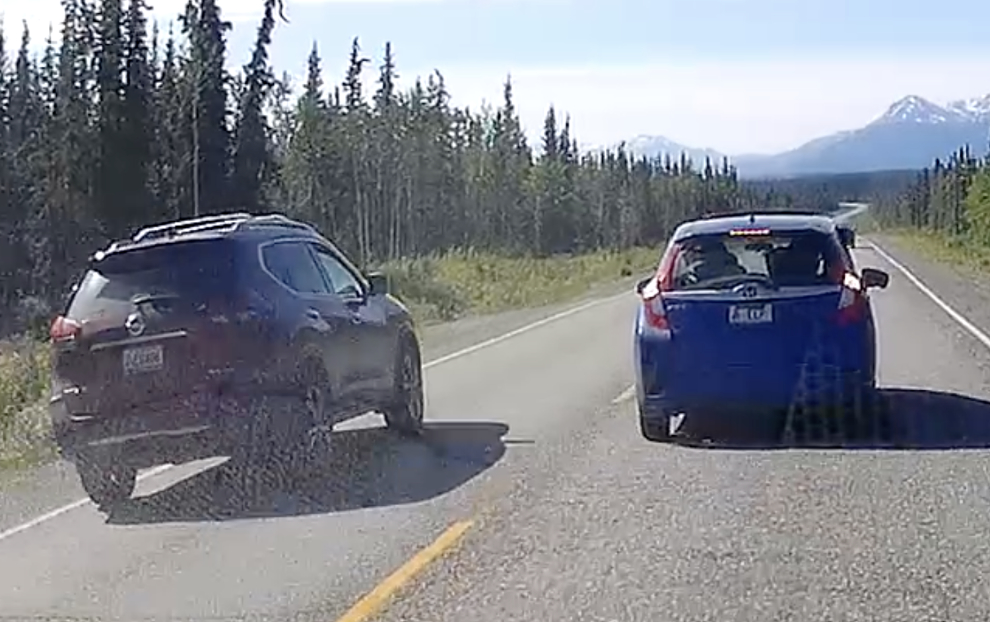
When we arrived at Carcross I was very surprised by the number of people. I was told there were 2 rail cars available on the train, so limited seating (84 seats). Locomotive 73 had arrived the previous night and was in the train shed over by the highway bridge. At 11:40 she was moved into town.
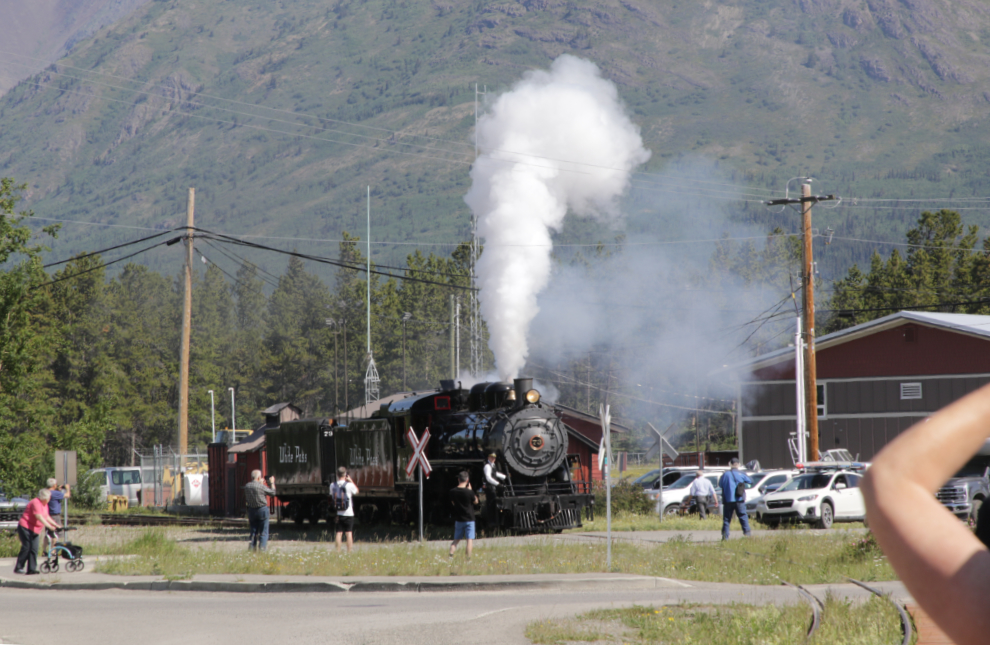
Carcross is certainly one of the most scenic of Yukon communities.
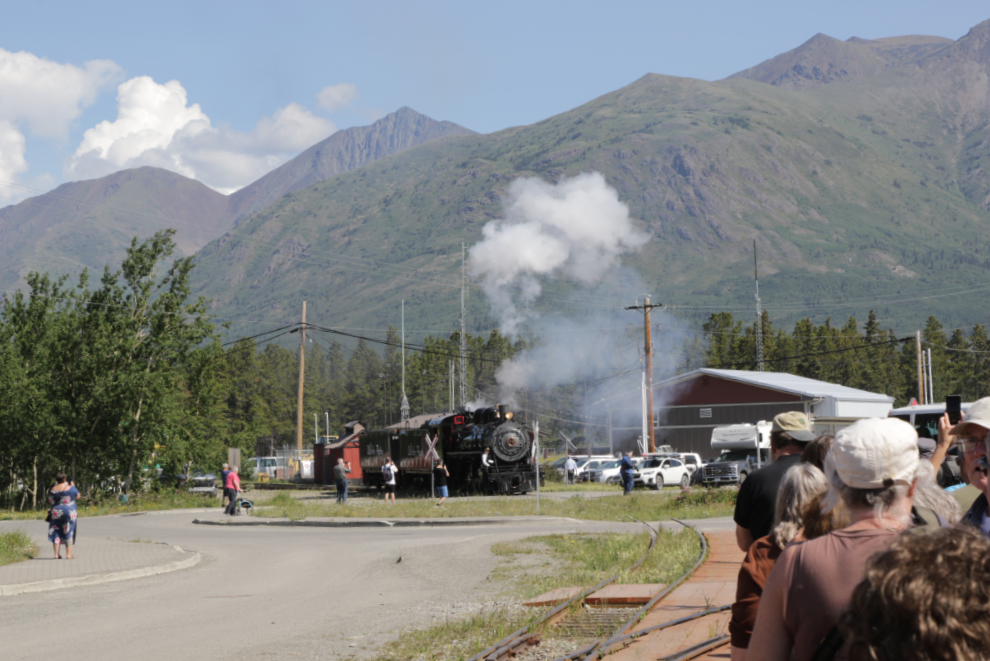
Hmmm – GE work engine #90 was hooked up behind 73. That’s odd.
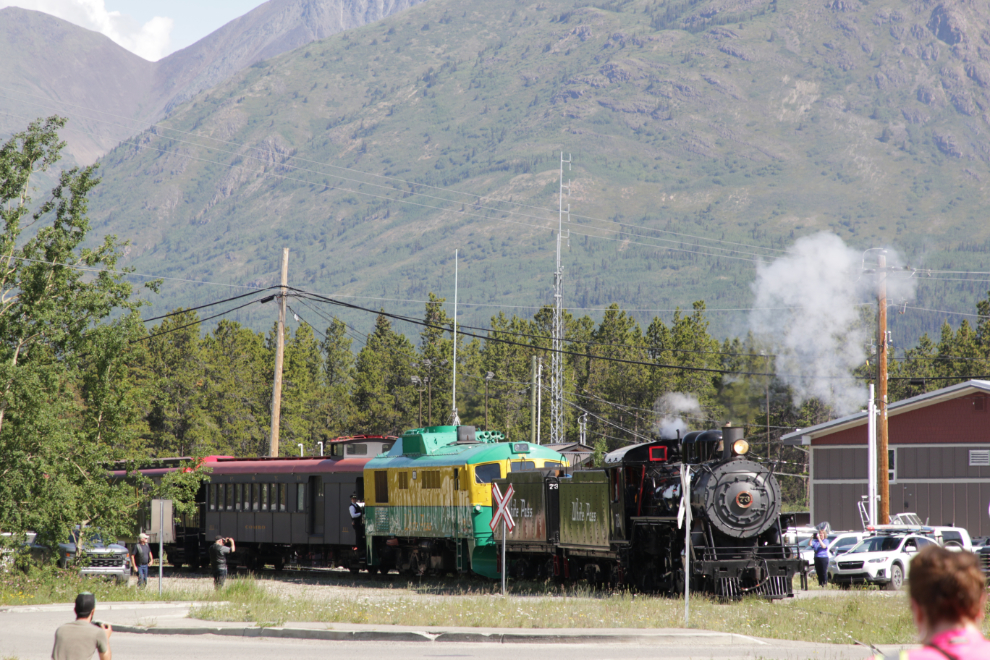
What an incredible machine!
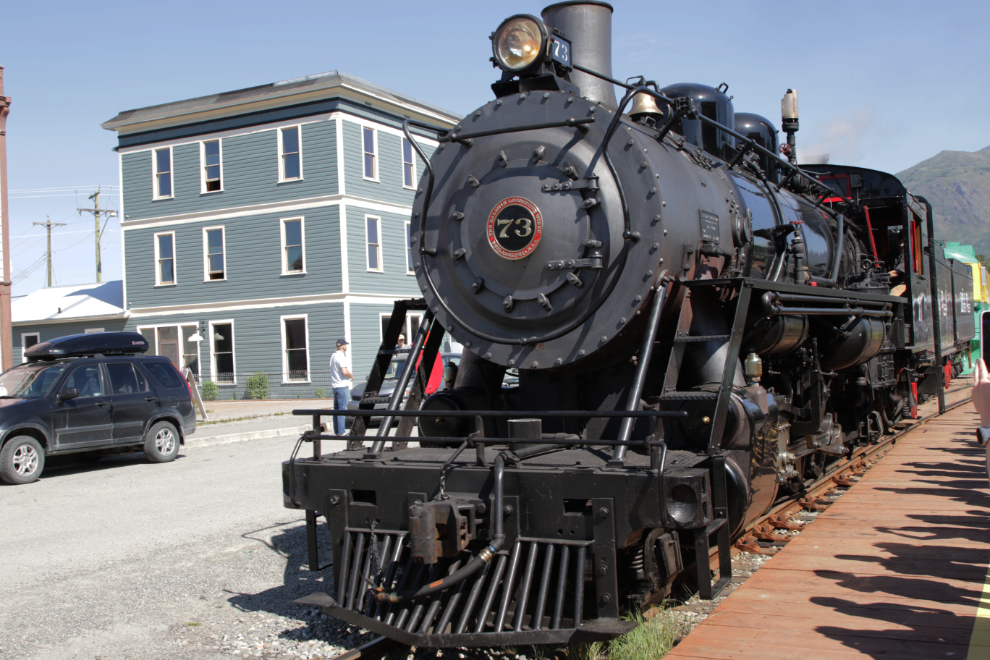
It soon became apparent what was going on – there were 10 passenger cars, 8 of them available to board. Thus a lot of people and a “helper” engine. I guess as White Pass got more and more requests for tickets, they just kept adding cars. The vast majority of the people were Yukoners.
Boarding went very smoothly, and right at noon we pulled away on an absolutely perfect day. I have a long history with Carcross and Lake Bennett including living full-time year-round on the shore of the lake for 7 years. Cathy’s history is shorter and less intensive, but we talked a lot about what it felt like to be back. I had said I would never leave Carcross, but then life changed and I joined Cathy in Whitehorse. A warm nostalgia probably sums up both of our feelings well. Our Carcross experiences gave us a lot to be thankful for, including the fact that if not for Carcross we may well have not met.
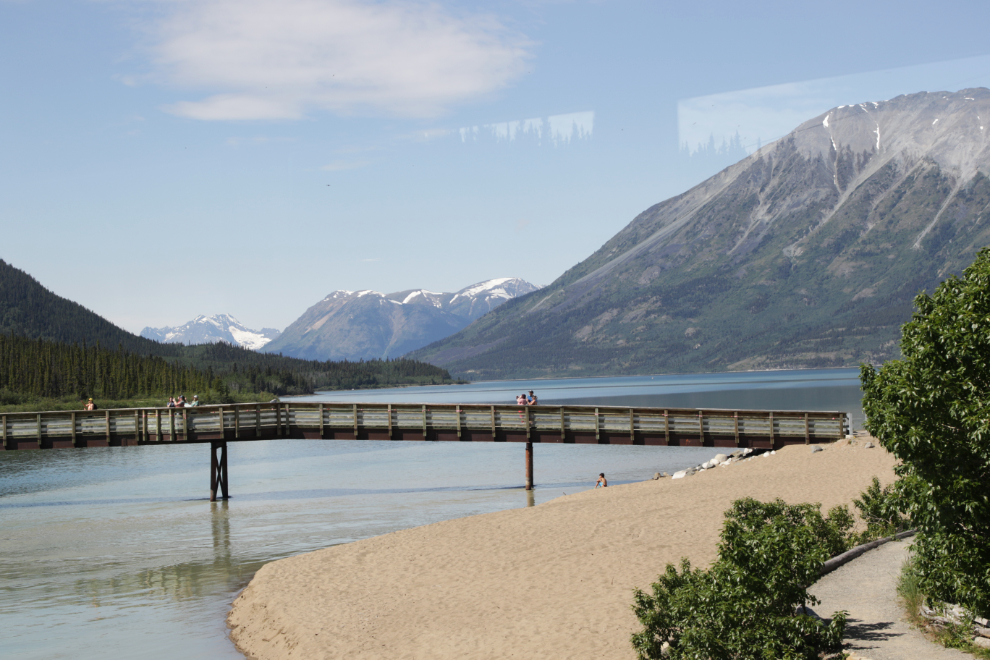
Over the years I’ve posted a great deal of information about the White Pass & Yukon Route railroad on my RailsNorth.com site, including detailed route information and hundreds of photos linked from the Trip Guides & Journals page. I’ve walked the 26 miles of track between Carcross and Bennett at least 3 times before trains started running that section regularly, and canoed along it several times, so this trip brought back many really nice feelings.
Carcross is at Mile (MP) 67.5 from Skagway, the Yukon-BC border at MP 52.6, and Bennett at MP 40.6. The schedule called for 90 minutes travel to Bennett, an hour at Bennett, then back to Carcross by 4:00.
I used to spend a lot of time on the beach seen in the next photo – it was the closest private beach to my cabin, just a 15-minute walk.
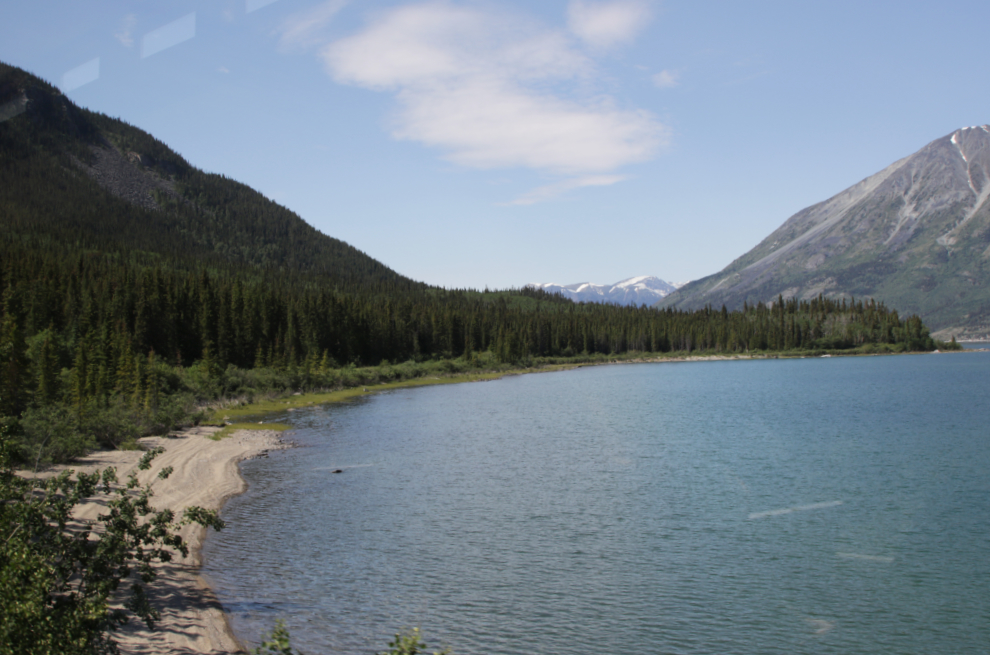
There are miles of good beach-walking along Lake Bennett, but also many miles with cliffs and boulders that make walking difficult or impossible. The next photo was shot at 12:08 – the locomotive is just about to pass the MP 66 sign.
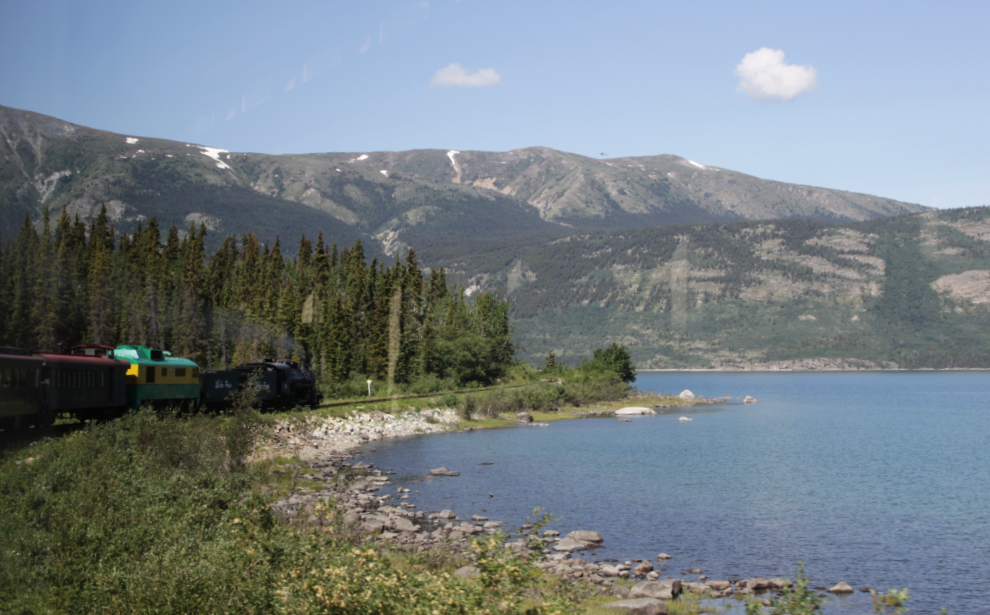
The closer you get to the West Arm, the more spectacular the views get.

Just past the wooded point is MacDonald Creek, at MP 62.8. A large steam-and-hydraulic power plant on the point used to be visible from the tracks but is now well hidden by trees. It was built in 1911 to supply electricity to silver-mining operations on Montana Mountain.
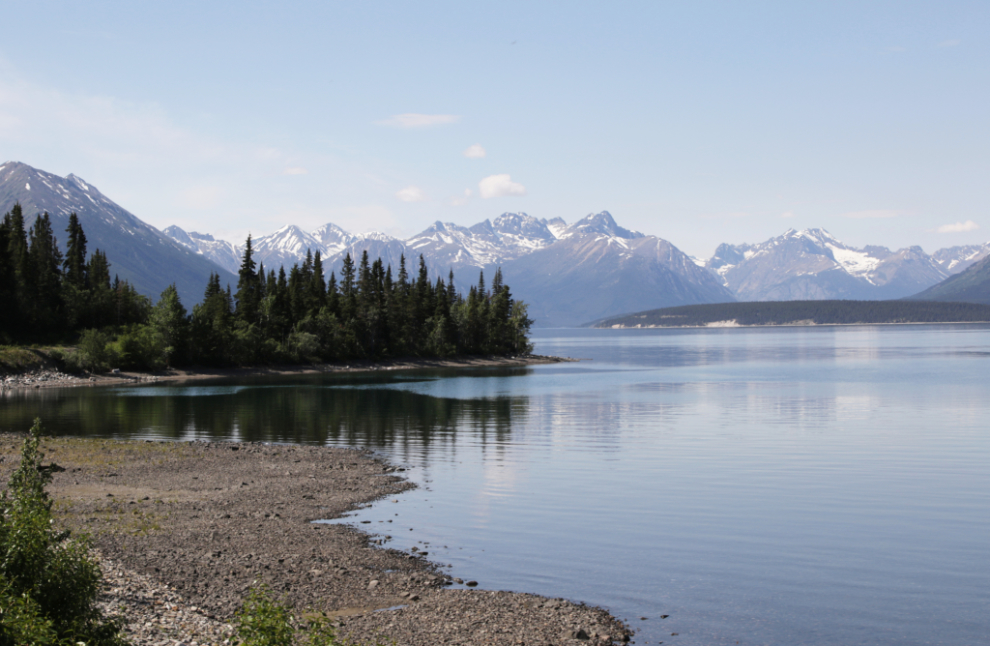
I think it was in the late 1990s that that large landslide above the West Arm came down.
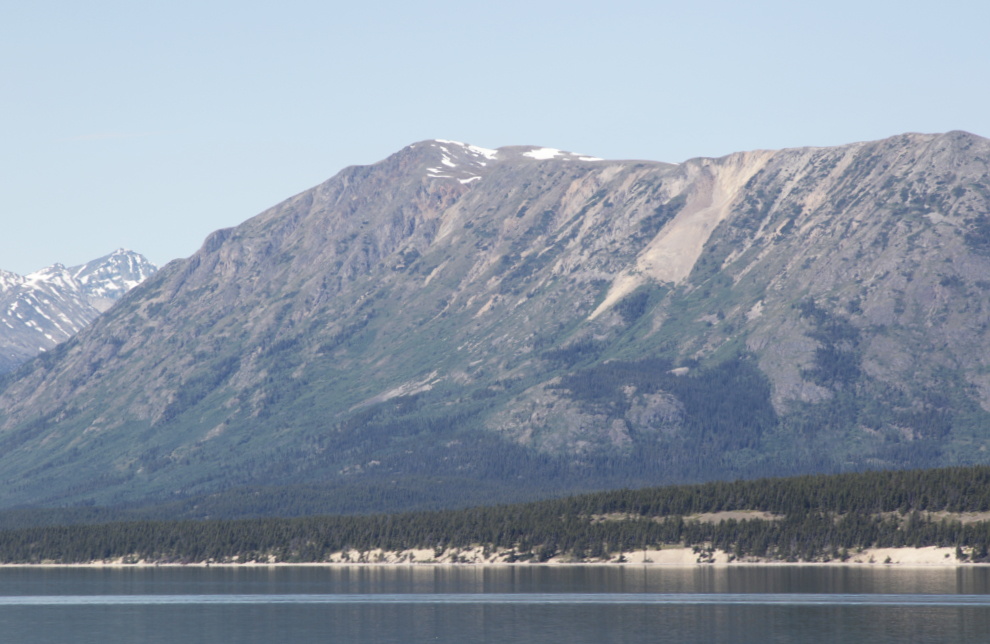
The view ahead at about MP 60.
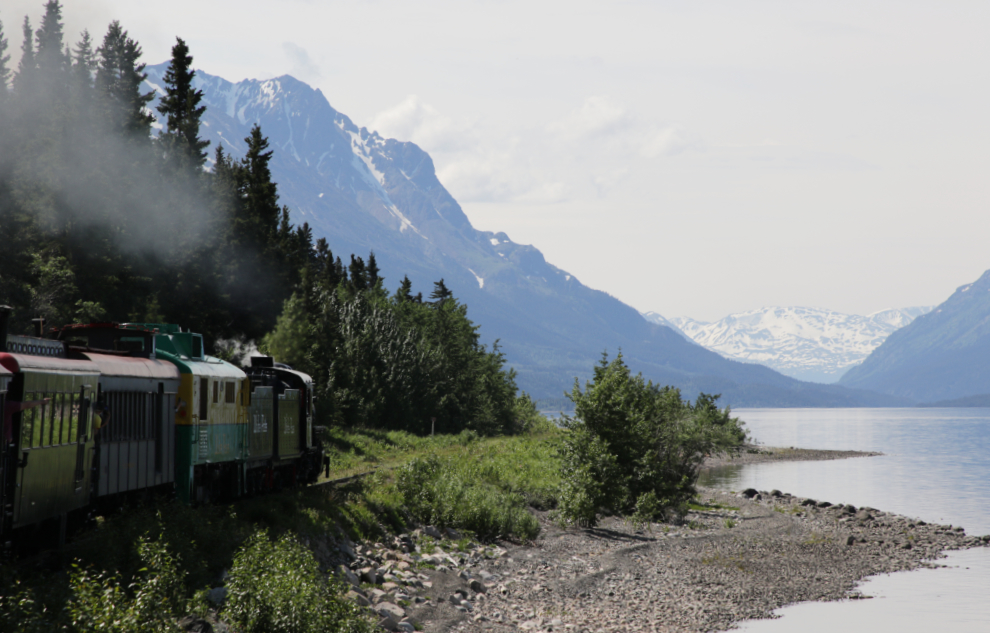
Looking up the West Arm, which is about 22 km long.
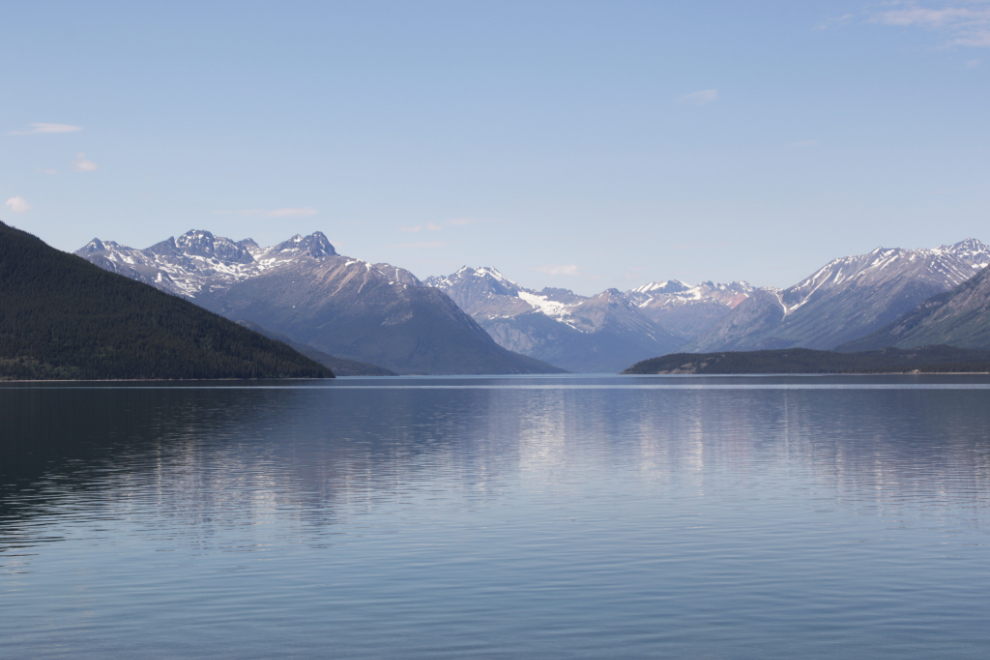
At 12:30 we stopped at the Watson Siding at MP 59.6, the brakeman got off and pulled the switch, and we pulled onto the side track to let the regular cruise ship train go by. The Watson Siding is 1,656 feet long, the longest along Lake Bennett.
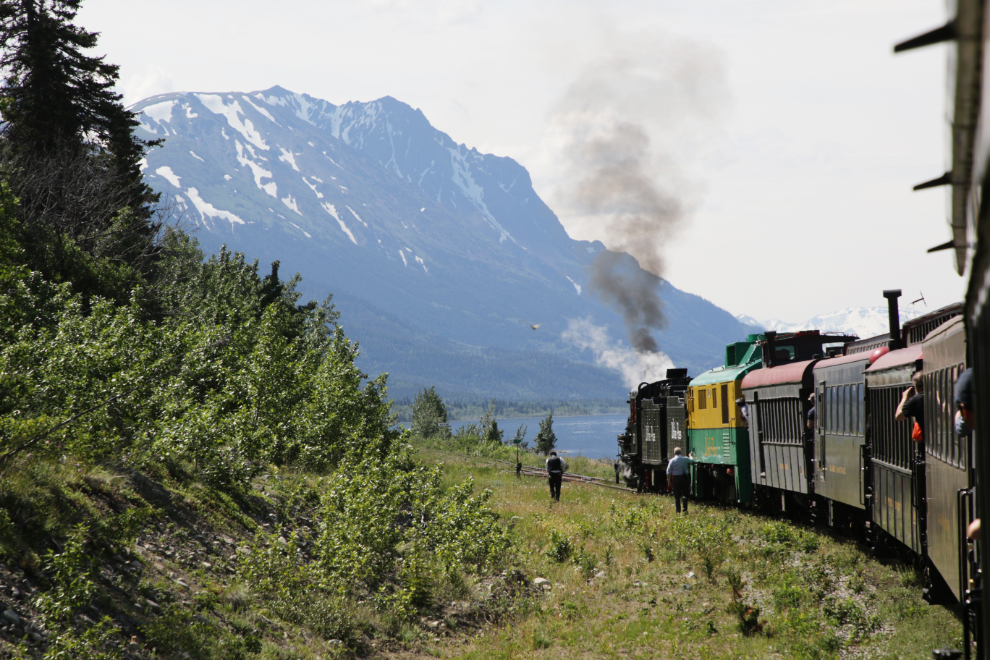
A young Arctic ground squirrel (Urocitellus parryii) was intrigued by us 🙂

One of the ways the initials WP&YR got used in the old days was “Wait Patiently & You’ll Ride.” That’s what we did for a few minutes at Watson. I sure wanted to be down on that beach for a day or three. A friend from Haines says he wants to canoe the lake for 3-4 days with me this summer – I need to send a prompt to make that happen.
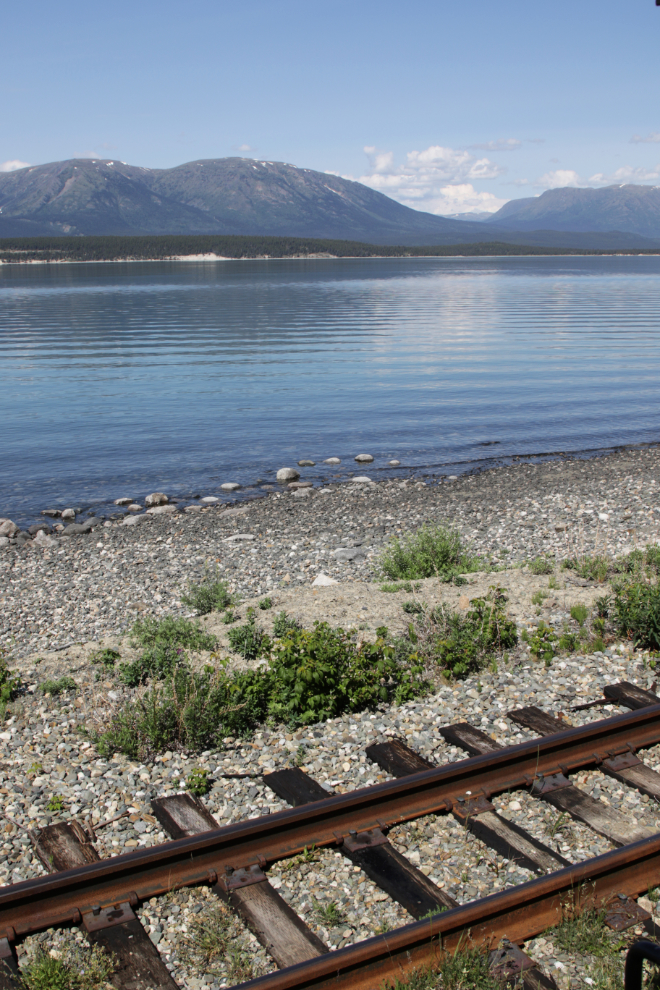
GE #98, built in May 1966, is one of the few GE locomotives that’s still in service. Their low horsepower (990 hp) makes them only useful for a few short trains such as the ones on the regular Skagway-Carcross run (there were two passenger cars on this one).
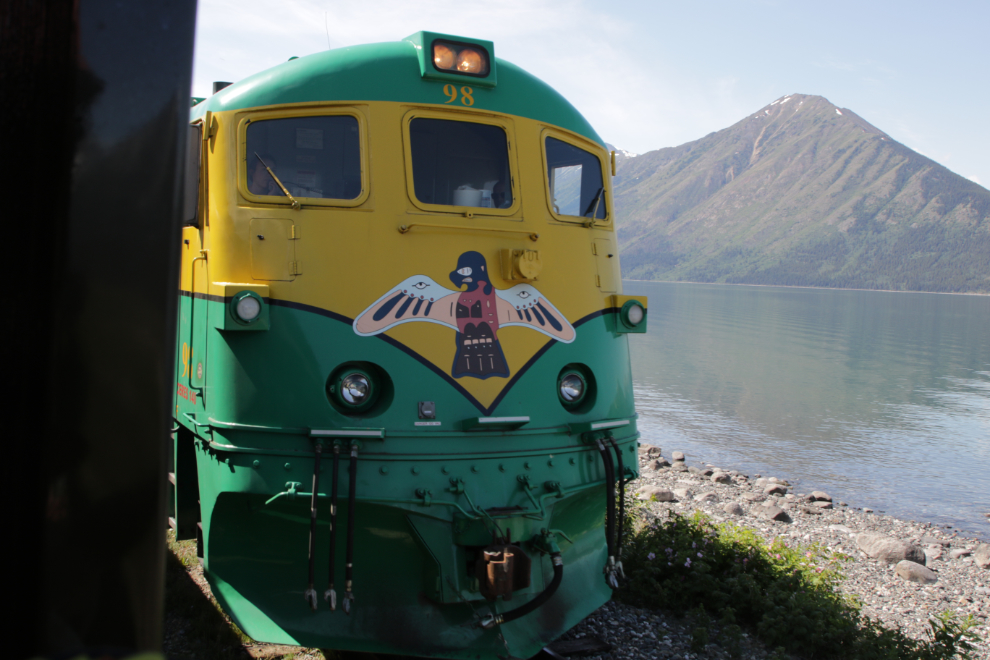
Looking north as they passed us.
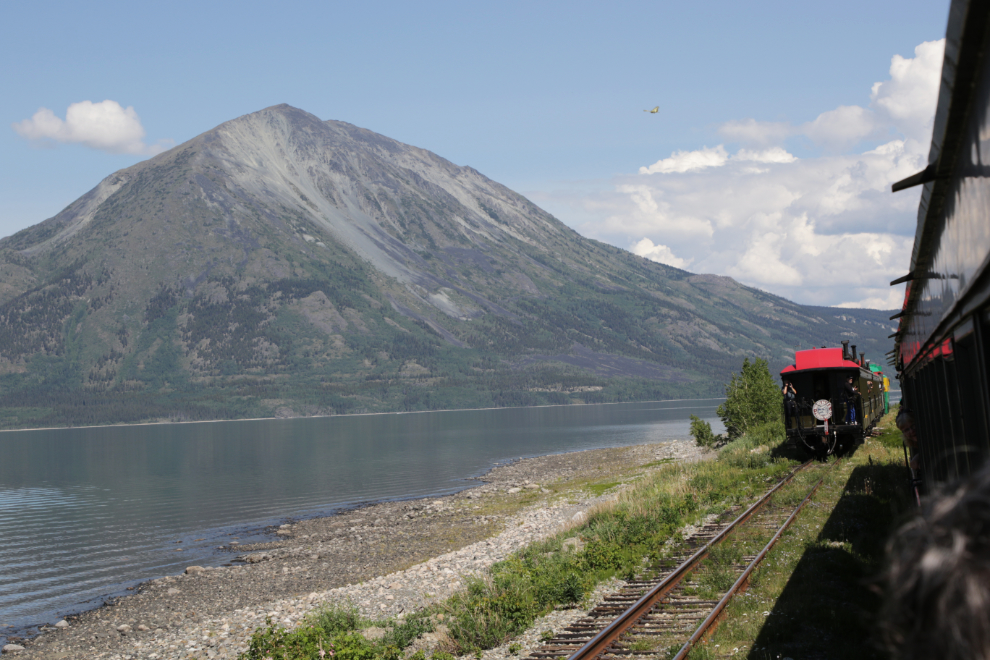
The sign at the middle of the Watson Siding. We moved up to the south end up the siding, the Brakeman got off and threw the switch, and we were on our way again. The whole process had taken about 15 minutes.
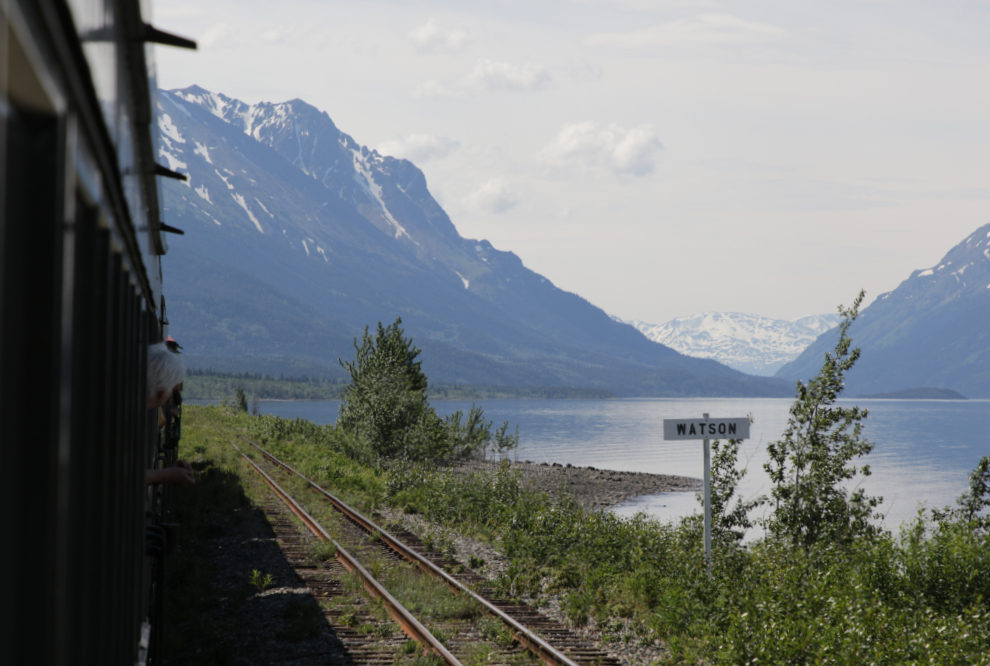
A creek that seems to be unnamed, at about MP 57. From here south Lake Bennett narrows dramatically, hemmed in by mountains 5,500-6,000 feet in height.
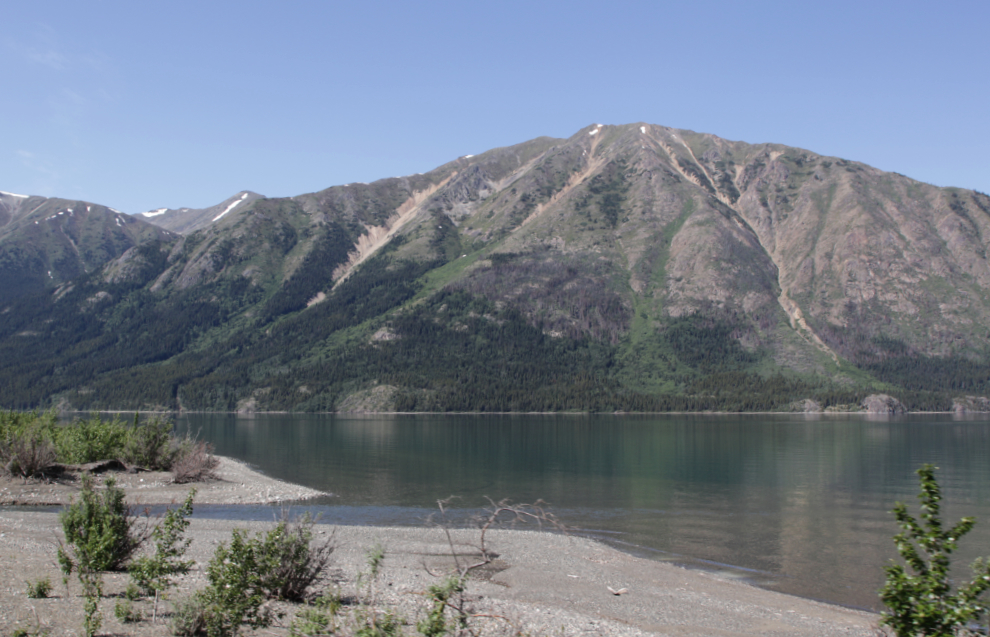
The scenery changes constantly – the next four photos were shot in a 6-minute period from 12:54 to 1:00. You might notice a rather substantial change in the elevation of the tracks. In 2001 as preparations were being made to resume regular service to Carcross, an enormous of amount of work was done on the rail line, including erosion control work on the low-elevation sections.
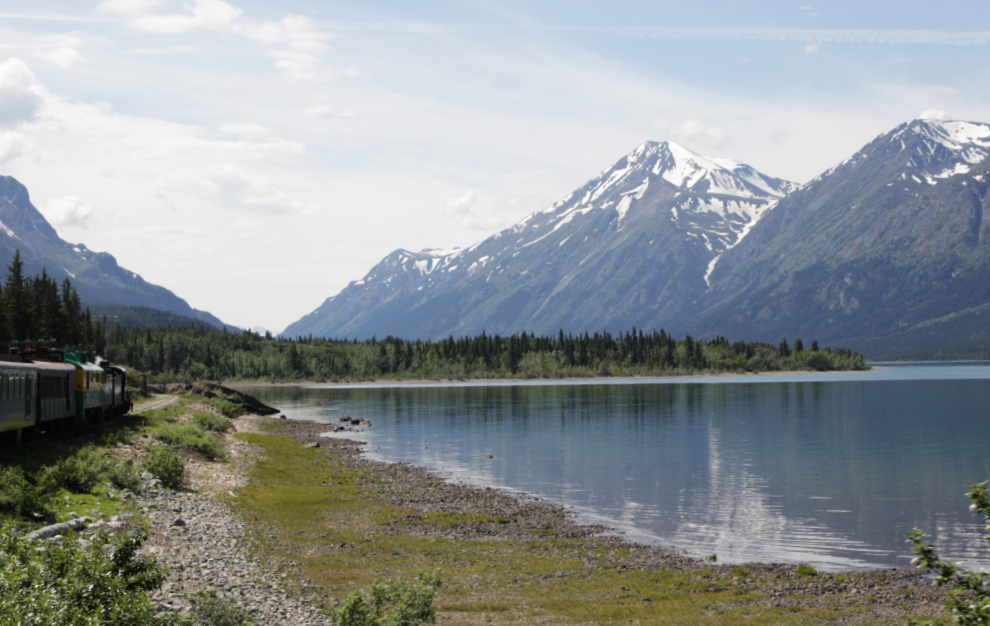

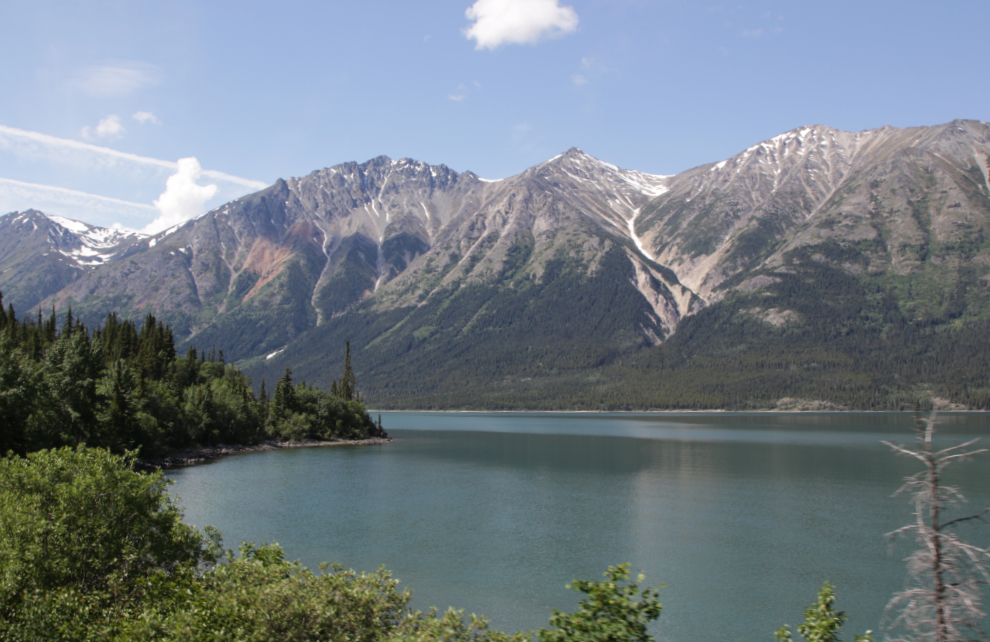

As the lake narrows, the shoreline gets more challenging for railway engineers and you can see that more and more blasting was required to build the line, and still is to reduce sharp corners as the line is rebuilt. The next photo looks back to the north.
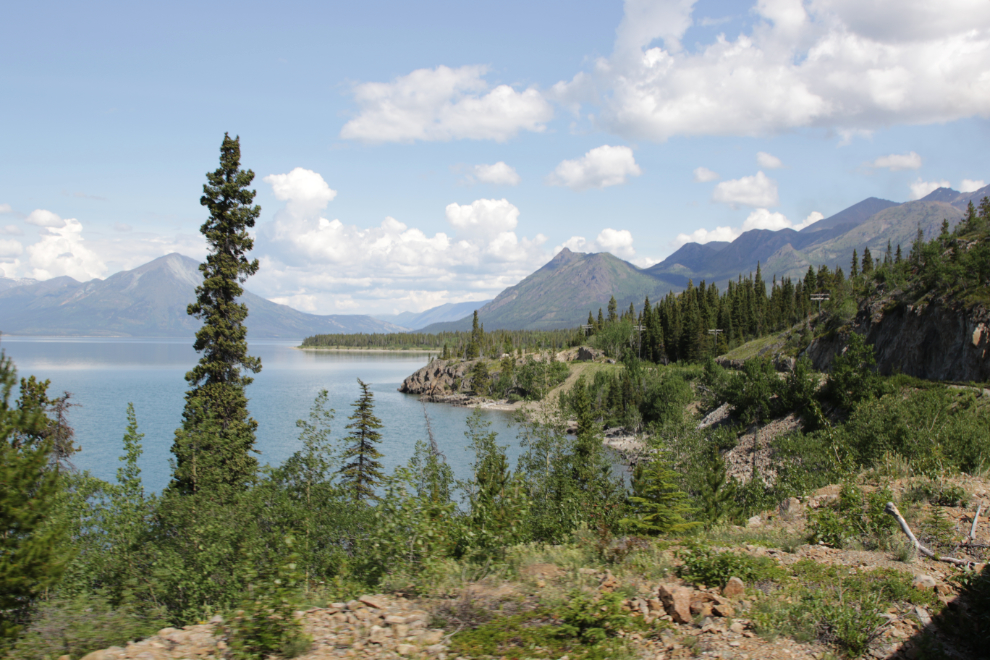
The next photo shows one of my favourite spots on the lake, an island I call Boundary Island because it’s just a few hundred meters north of the Yukon-BC border, which is at MP 52.6. Camping on the sheltered north end of the island (prevailing winds are from the south in the summer) is simply superb – truly the Yukon at its finest. On the left side of the rocky knoll in the centre of the photo are the 1898 graves of Luc Richard and Thomas Barnes.

On an islet just south of the border, Tourism installed a “Yukon: Larger Than Life” signs. Historically there was a small “BC | Yukon” sign that’s now housed in the Bennett station.
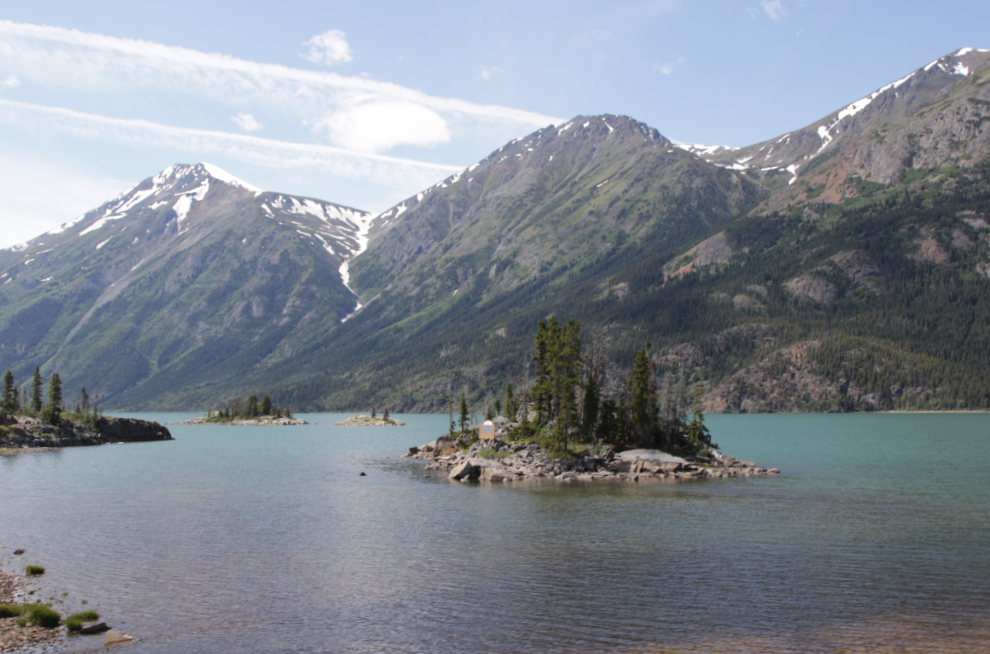

Pennington Station at MP 51.6 can be seen just ahead.
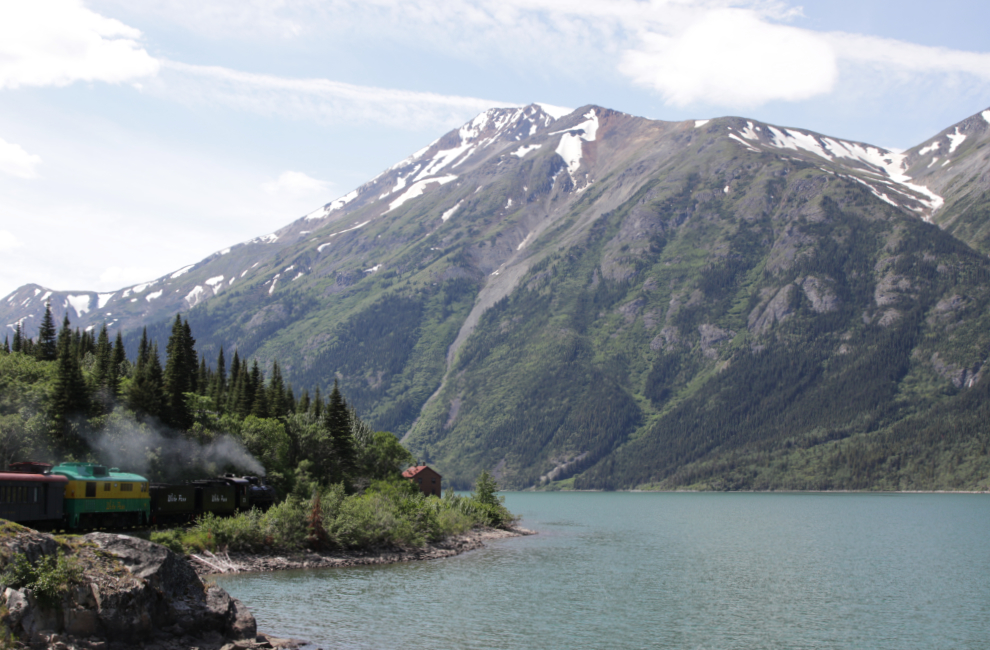
Back when I was young and full of dreams I envisioned Pennington rebuilt as a B&B, but the folks at White Pass quickly dashed that idea.
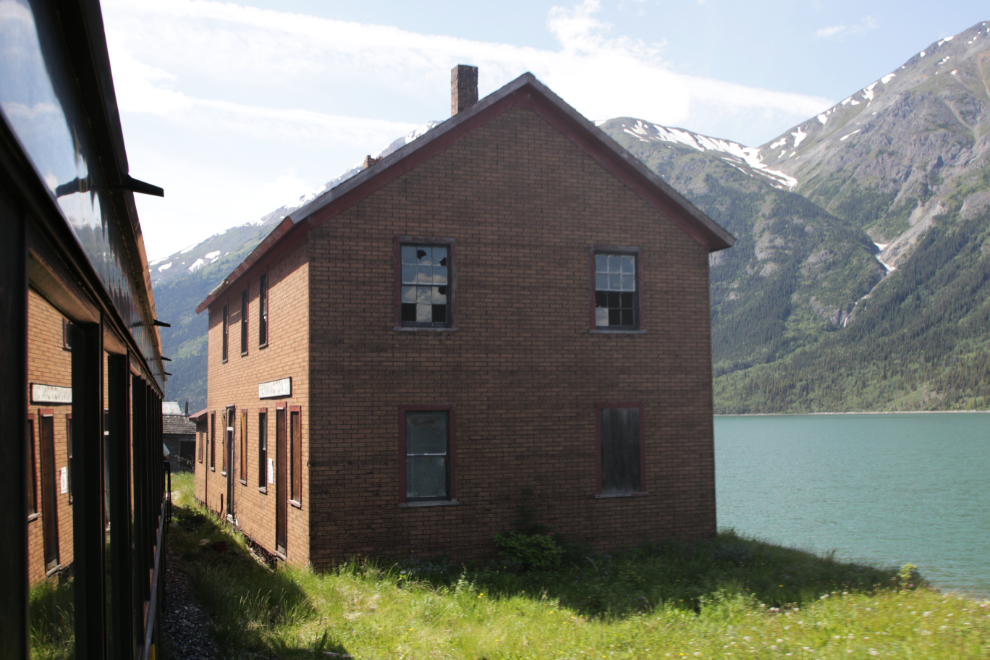

Yes, I still think it would 🙂 – but that’s a project for somebody else.
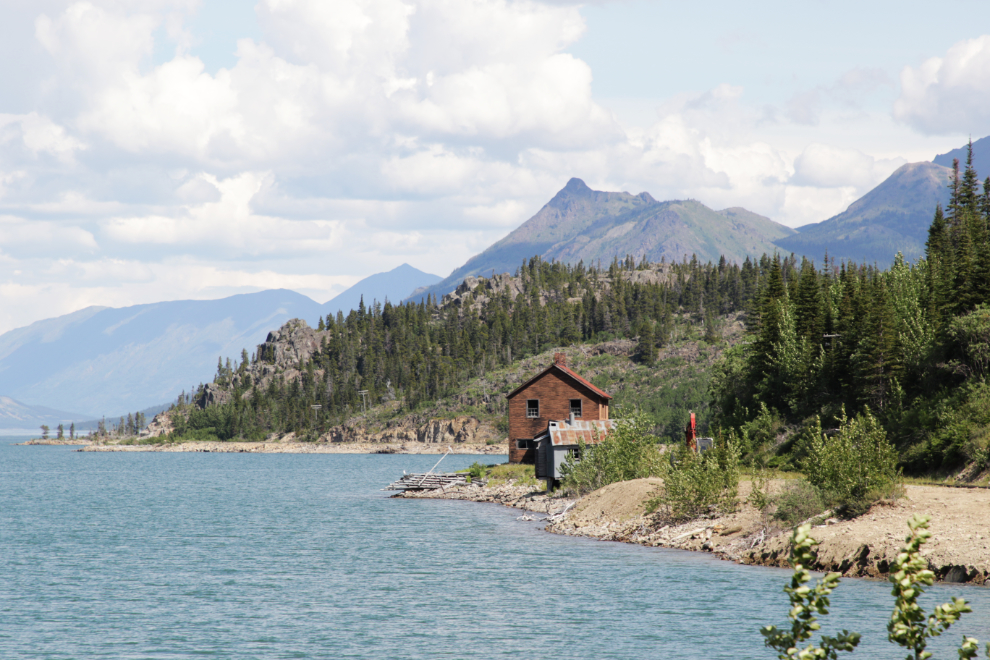
Think about the incredible amount of work it would have taken to cut through that rocky point 124 years ago!
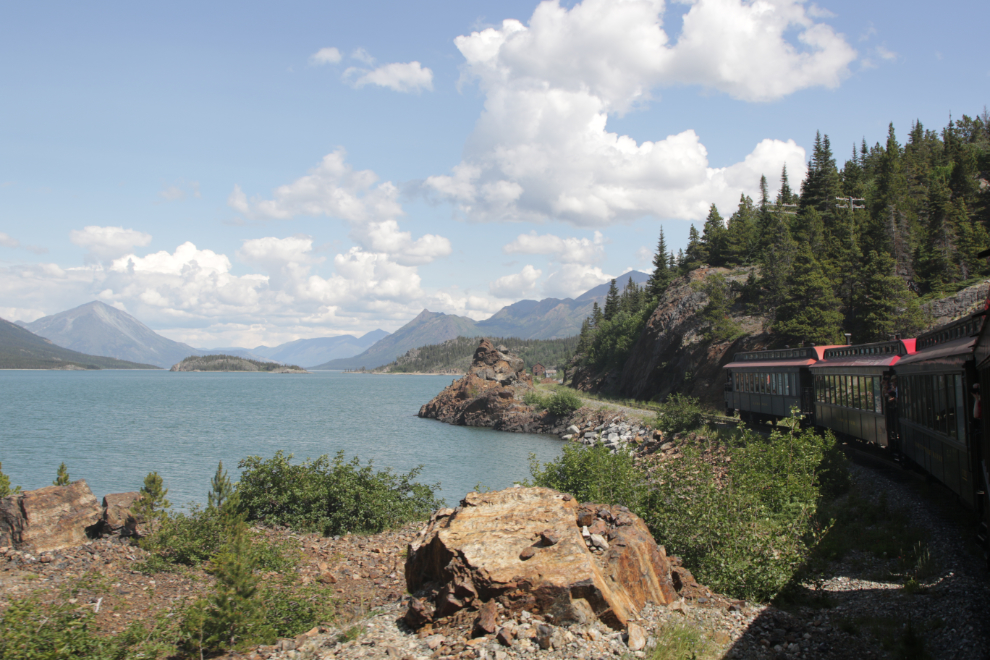
Just south of and across the lake from Pennington is a particularly fine waterfall. Many years ago I tried to climb up to the base of it, but soon gave up – the bush is much too thick.
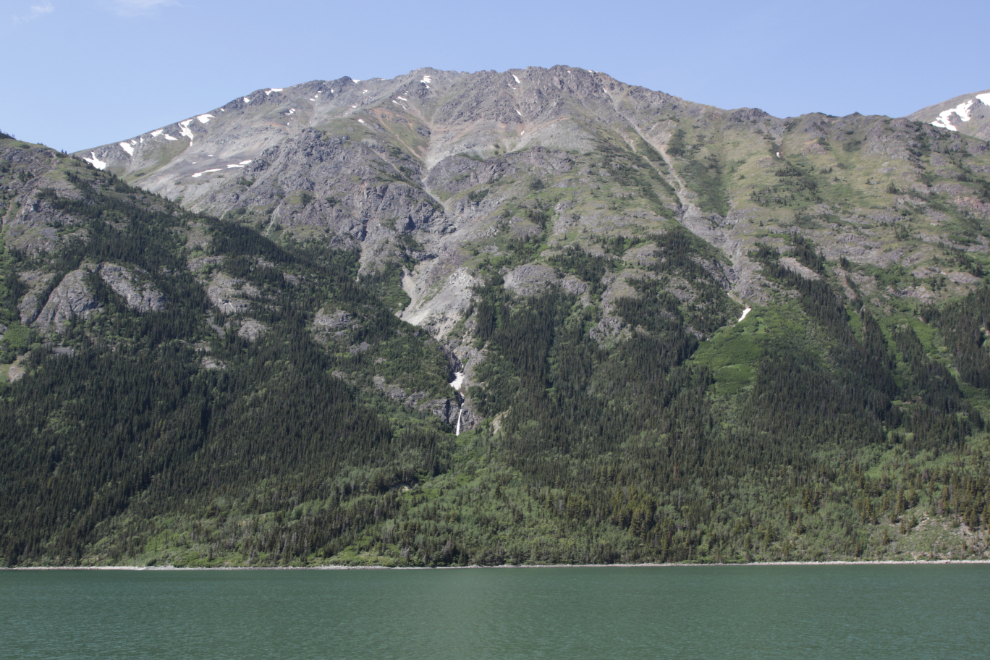
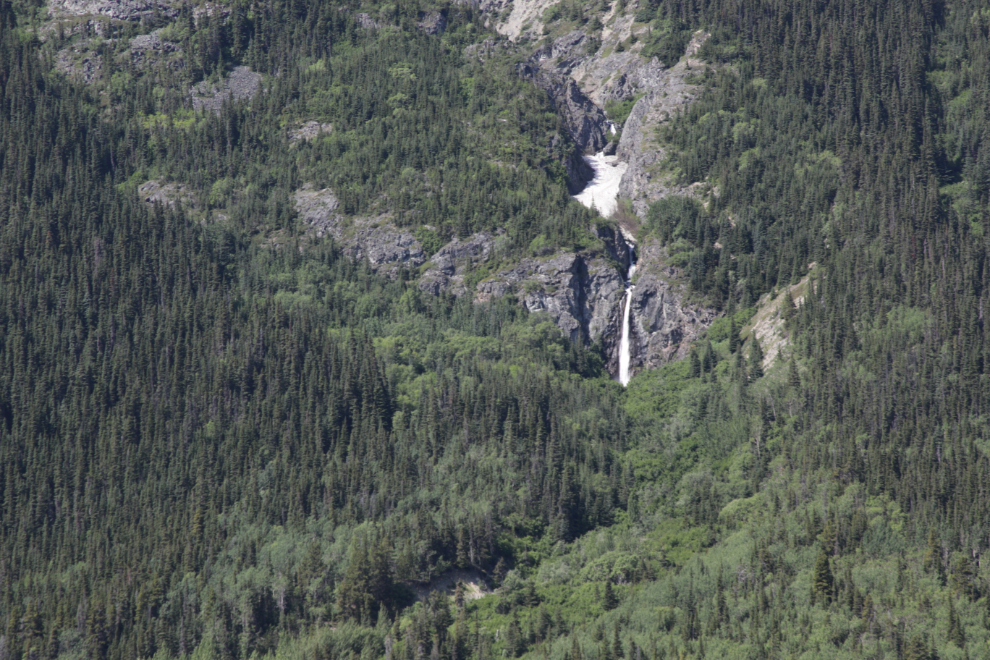
Southbound at about MP 50.
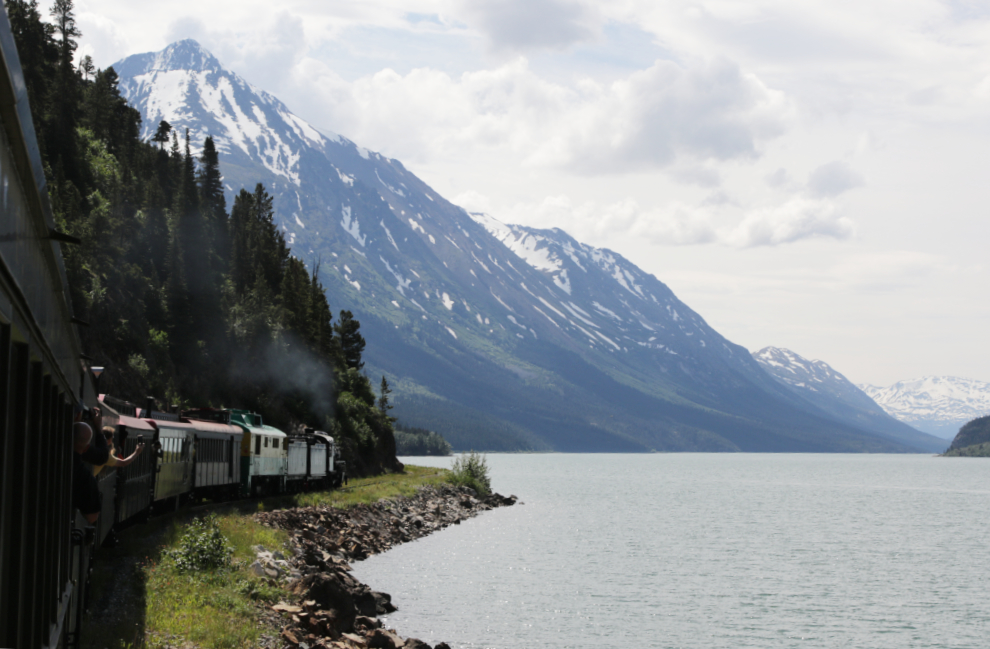
The siding at MP 49.3 was built in 1970. Originally called Heney Siding after Michael J. Heney, it was renamed Graves in 1989 after Samuel H. Graves, first president of the WP&YR, then in 2016 it was renamed again, for roadmaster Willi Scheffler.

That slope has always intrigued me – by the amount of erosion I expect it’s a narrow band of limestone.
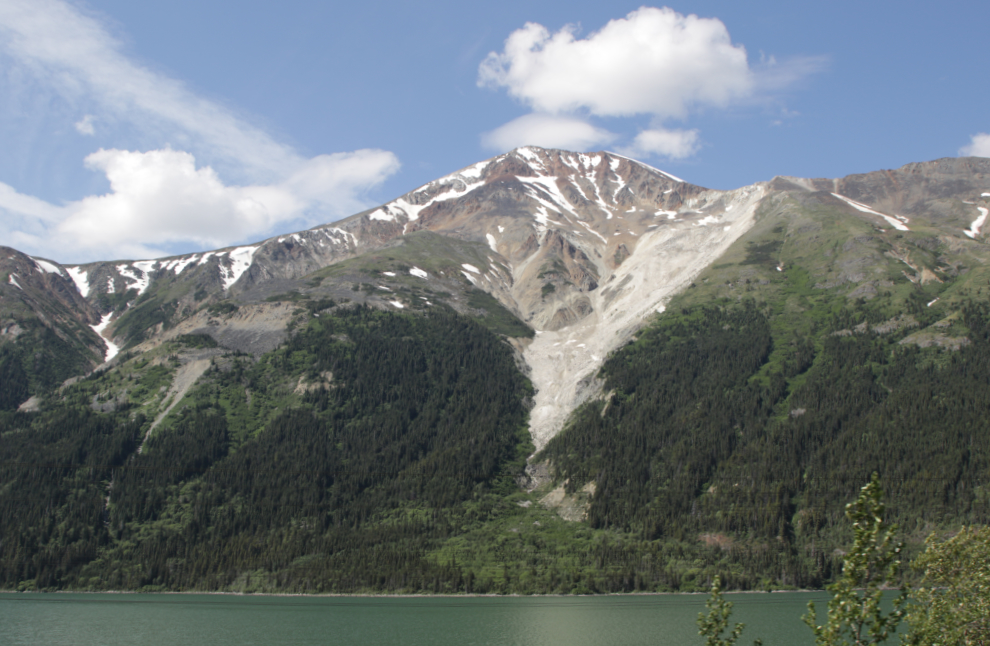
It’s remarkable what you see in only 26 miles – that’s some waterfall!
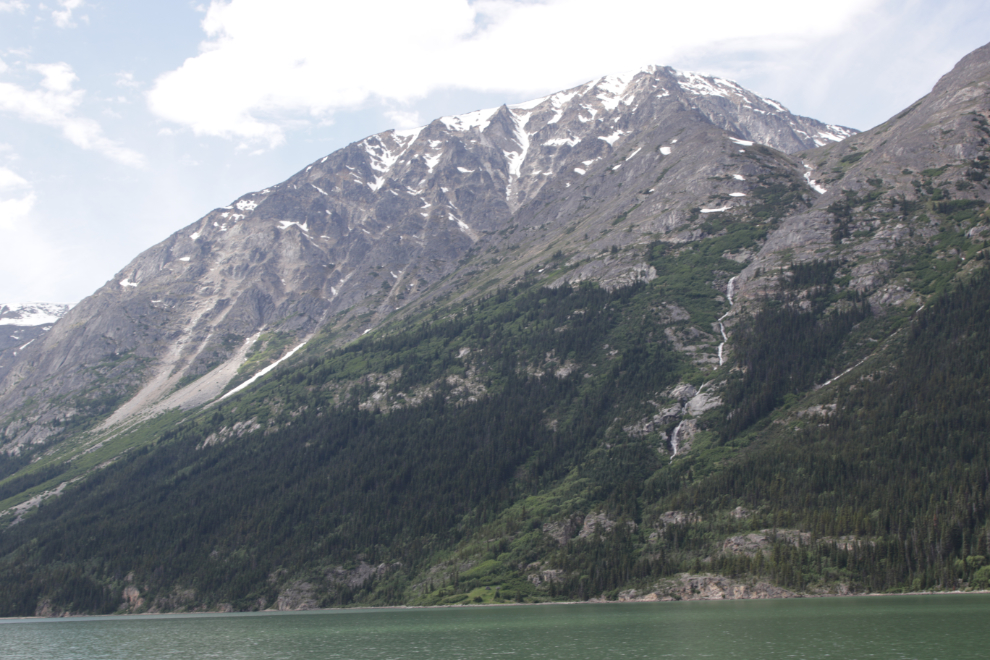

Another tight curve being rebuilt.
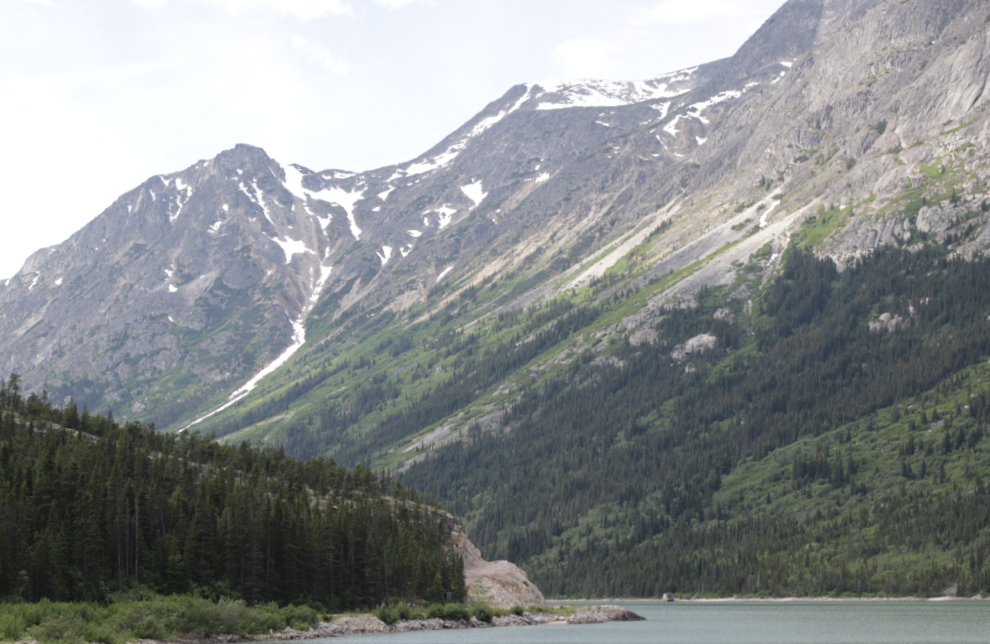
I believe this cabin is all that remains of the power plant for the Silver King Mine, which was about 4,000 feet above the lake – it was operated for a few years prior to WWI. The substantial remains of the power plant were demolished for some reason in about 2000.
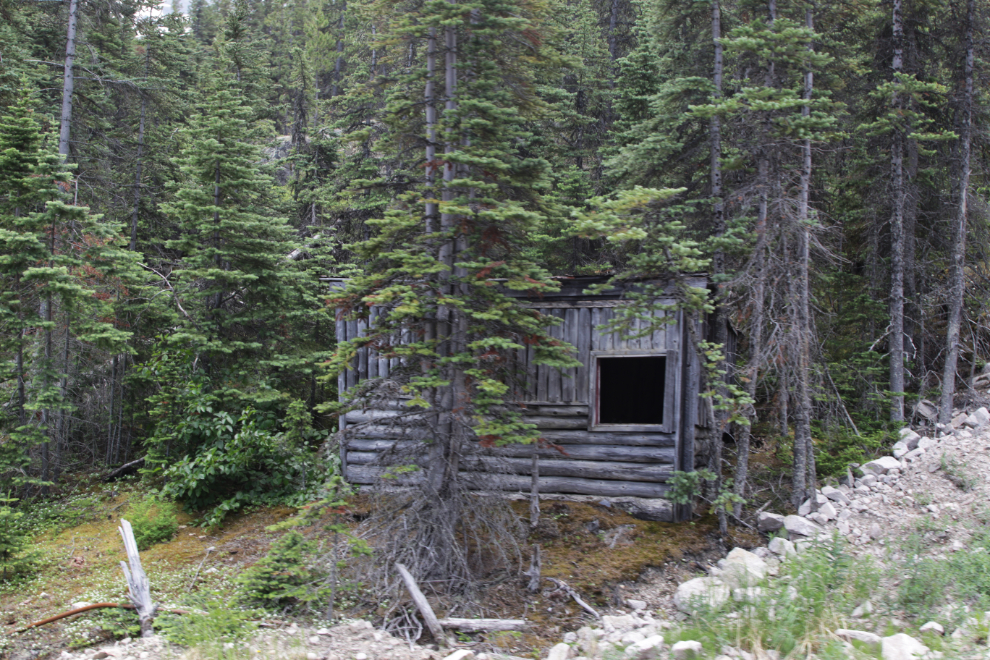
Building the line along Lake Bennett was so difficult that it was the last of three sections that were built. Skagway to Bennett was first, then Carcross to Whitehorse, then Bennett to Carcross. The largest blast ever on the White Pass & Yukon Route happened along Lake Bennett on June 6, 1900 – an article in The Klondike Nugget the next day described what happens when 2½ tons of powder are fired.
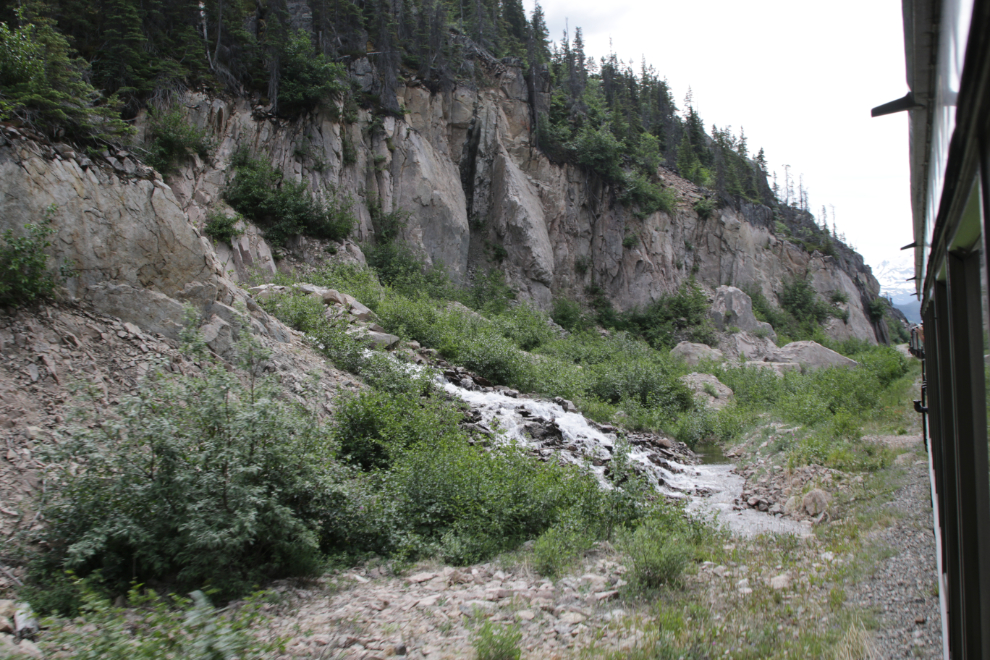
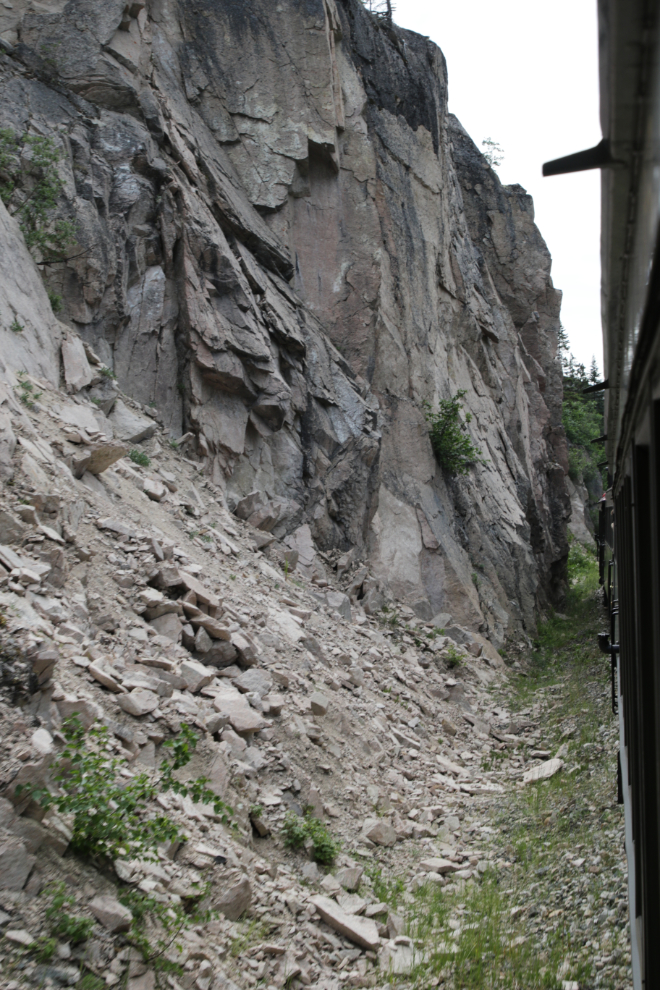
We arrived at Bennett eight minutes later than scheduled, and were told that the scheduled 1-hour stay at Bennett was being reduced to 45 minutes. I love Bennett, but the number of people made this a difficult place for me to be.
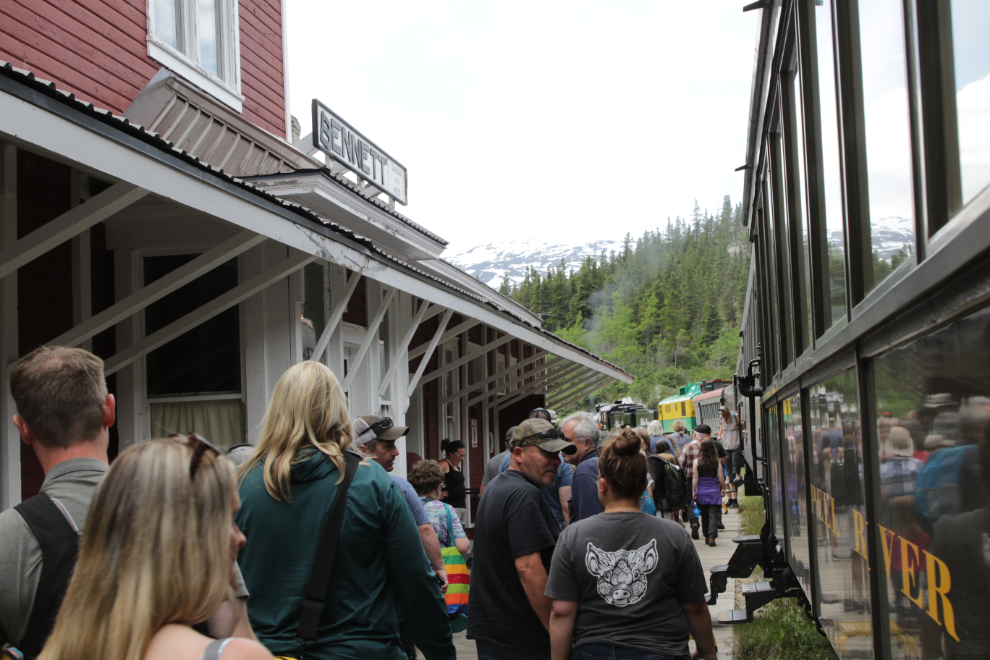
An excellent lunch used to be served in the Bennett Station (the Bennett Eating-House), but that was cancelled in favour of box lunches a dozen or so years ago, and on this trip you were told to bring your own. The museum was crowded and the bathrooms were overwhelmed and soon quit working at all and were closed.
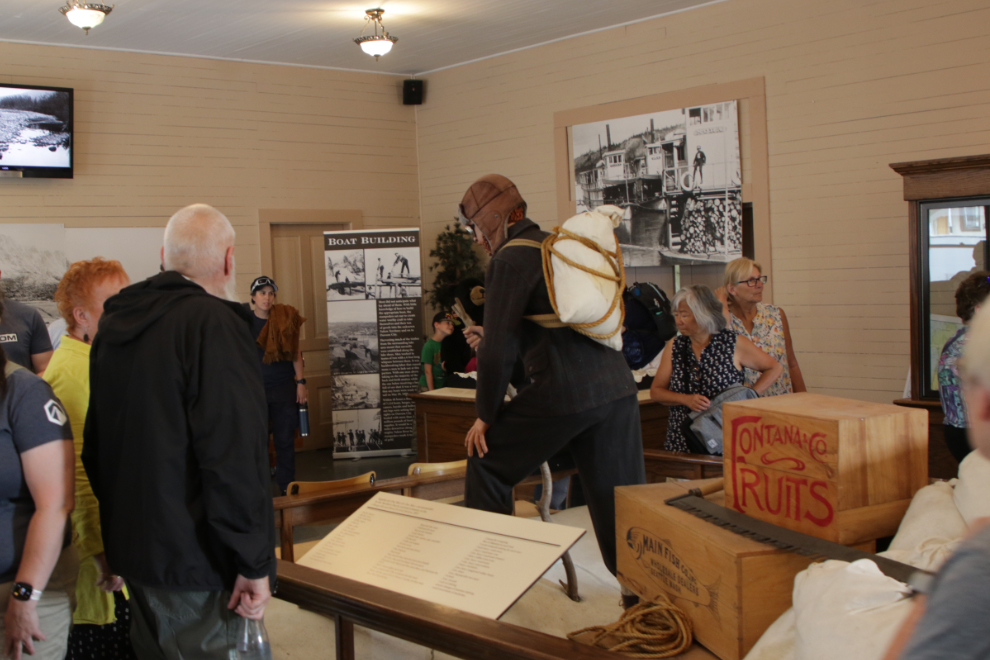
A Bennett Walking Tour brochure had been handed out, and many people scattered to explore. I noted that the Bennett Cemetery isn’t shown or mentioned in the brochure – when you’re on a tight schedule that would just be looking for problems 🙂
The next photo shows the entire train as it repositioned to return to Carcross.
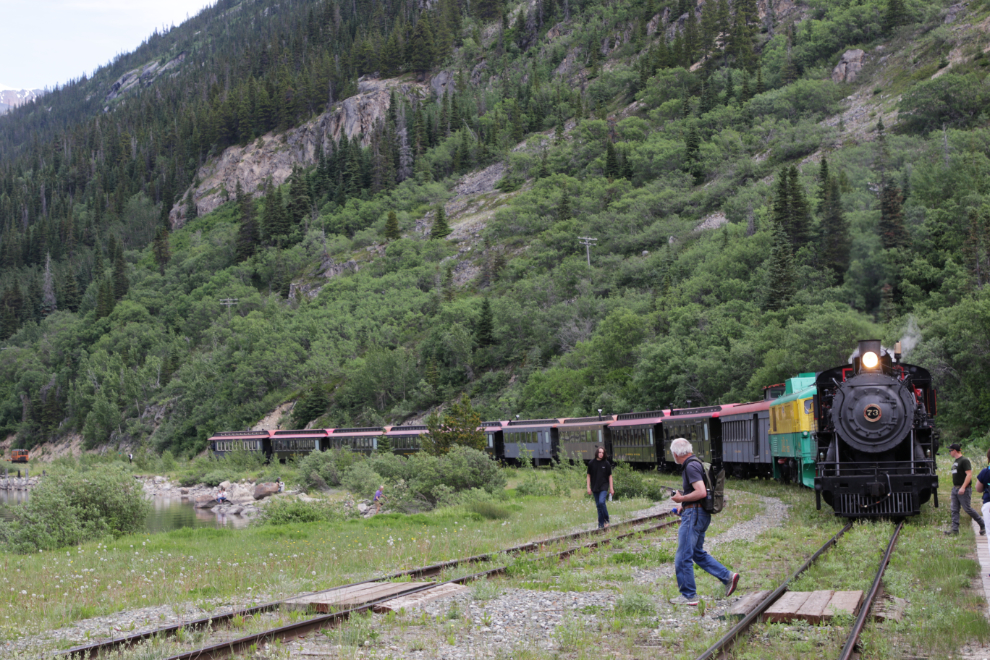
The Anglican church is rather miraculously the only structure remaining from the gold rush days, and is certainly among the most beloved of our buildings. It was never completed – the interior is barren. When the railway was completed Bennett’s reason to exist (a place to launch boats) ceased, everyone moved on, and the buildings were either taken apart or moved intact to other places (notably Carcross).
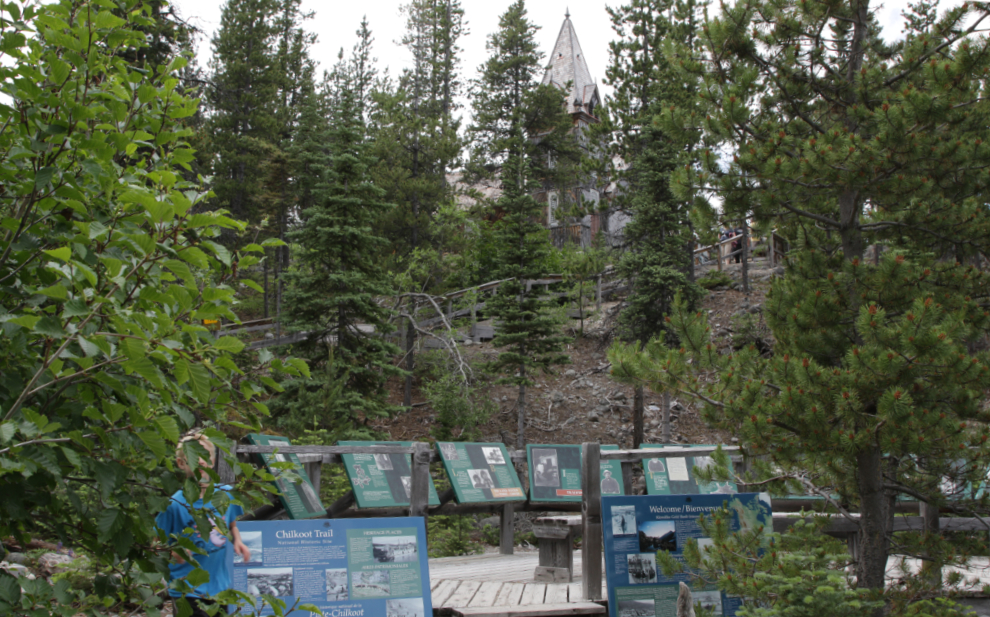
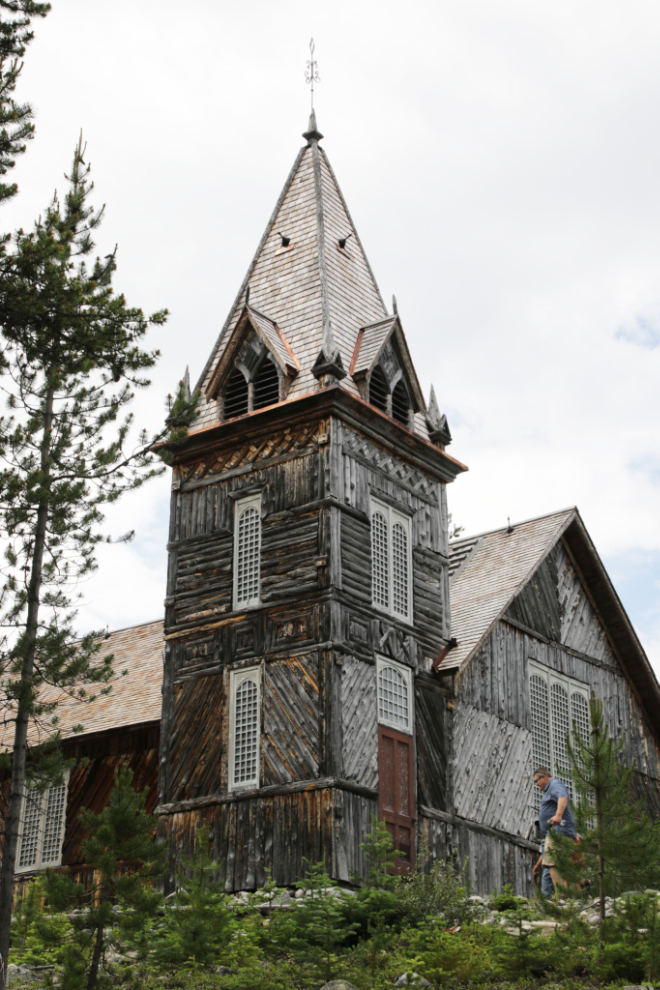
At Cathy’s request I had offered to show a family around the site, but before even reaching the church they had scattered to do their own things. I went down to the beach first.

It’s so much more beautiful without people 🙂
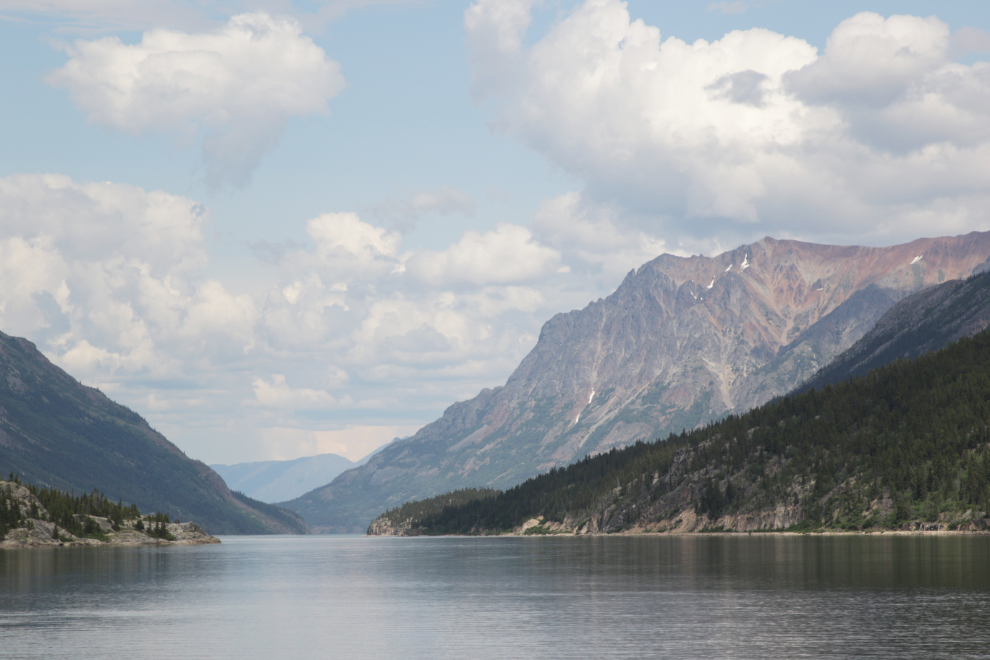
The shore along the mouth of the One Mile or Belle River is particularly interesting because of several deposits of broken glass, the remains of liquor bottles from the bars that helped many of the would-be prospectors make it through the long winter. At least one person in our group tried fly-fishing, with no luck.
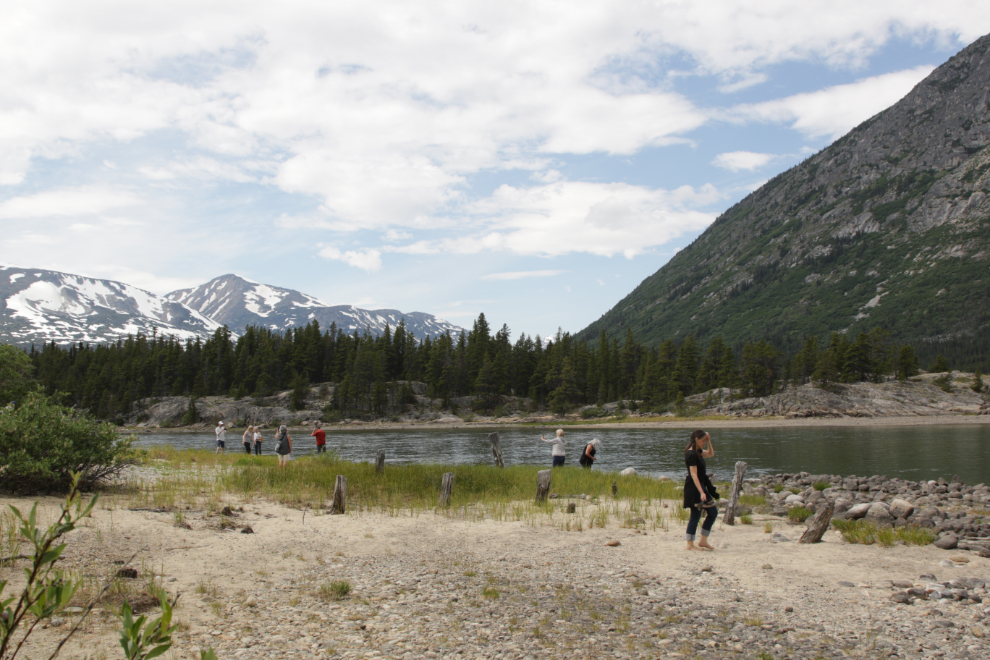
The Parks Canada outhouses along the Chilkoot Trail are unique. The house is on wheels so when the waste bucket is getting full, the house is rolled off and a helicopter takes the bucket of waste to Fraser for transfer into a suction truck. They were getting lots of use.
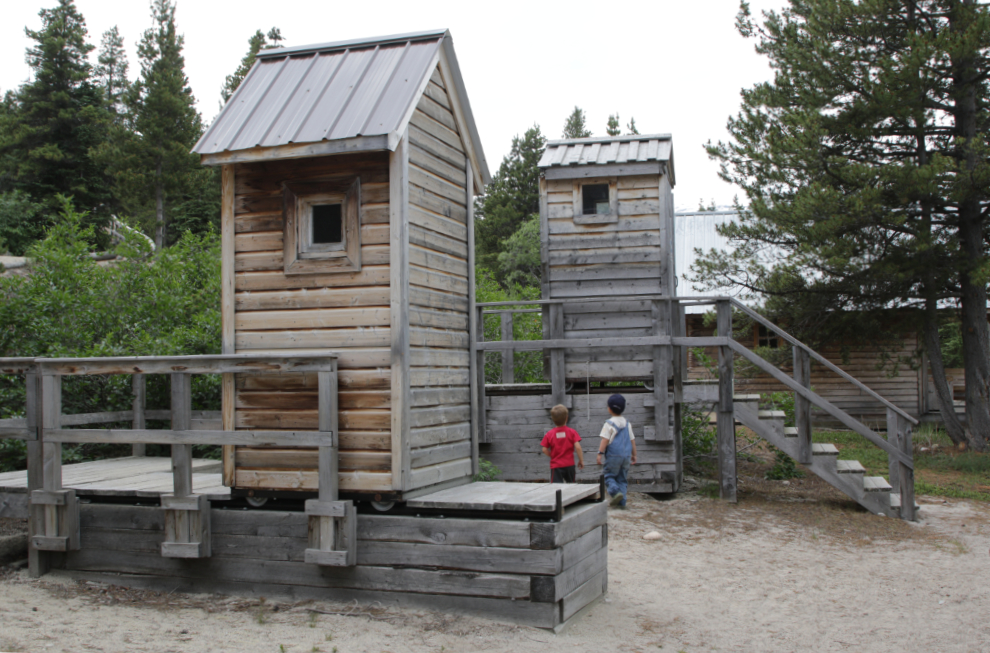
There are bear-proof lockers for campers. With the American side of the Chilkoot closed this summer for work including construction of new elevated walkways across the swampy and flooded sections of the trail, I don’t imagine there are many campers. Hiking just the Canadian section isn’t the experience that most people want.
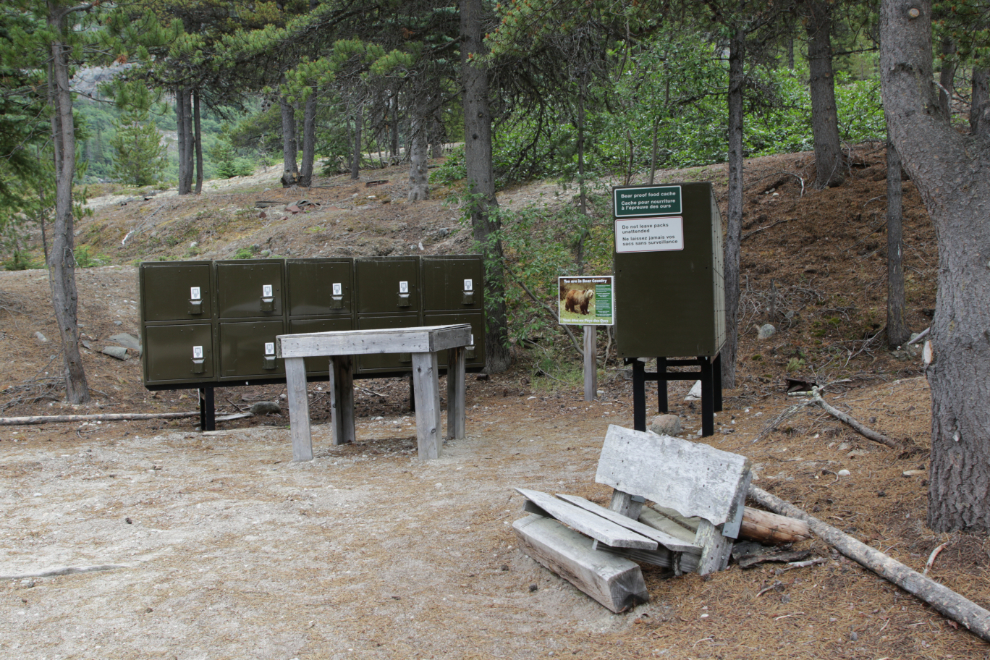
Cathy had given me her watch with the alarm set for 45 minutes, so I was back at the station at the requested time.
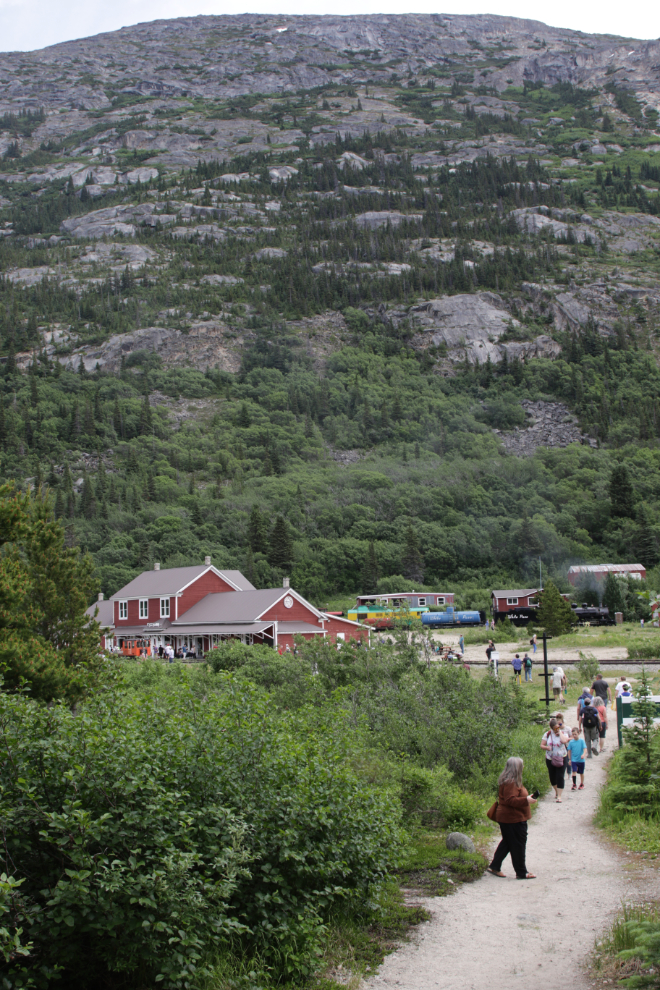
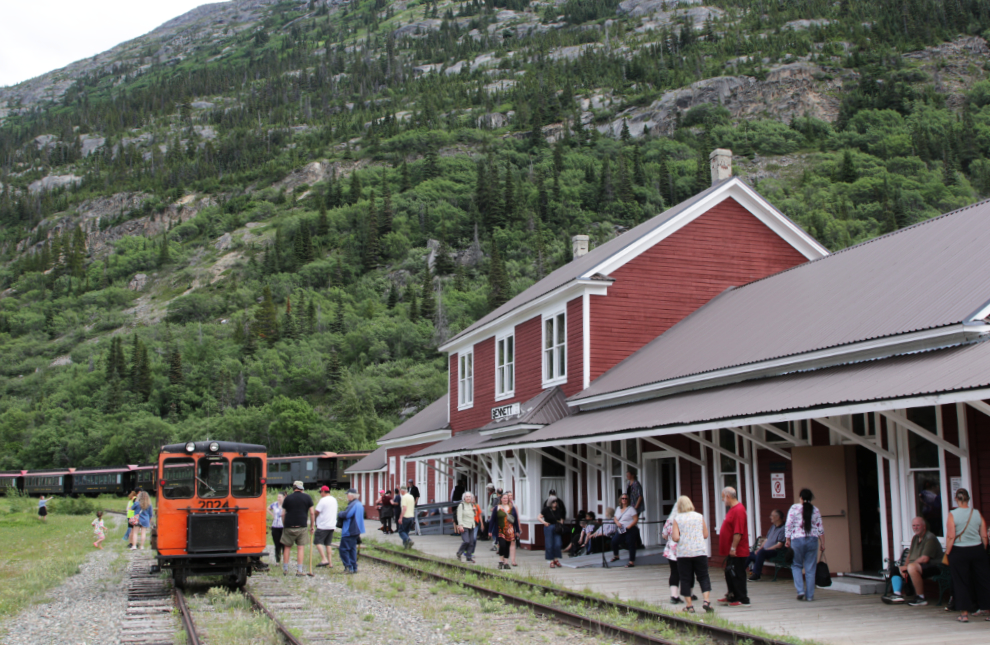
There were many people I knew on the train. The guy in the next photo is Harry Kern, who has a very colourful history in the Yukon, and on the railway specifically. He also has an amazing memory, and as a result, his Facebook page, Yukon Tales, is a wonderful source of good stories.
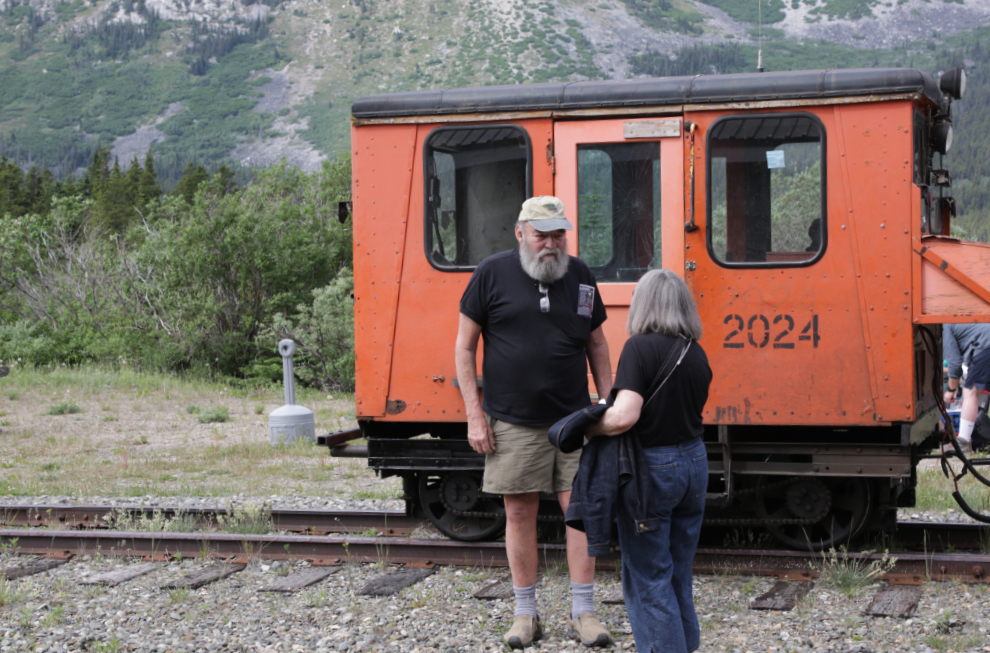
73 making another slow pass to make it possible for another few thousand photos to be shot 🙂

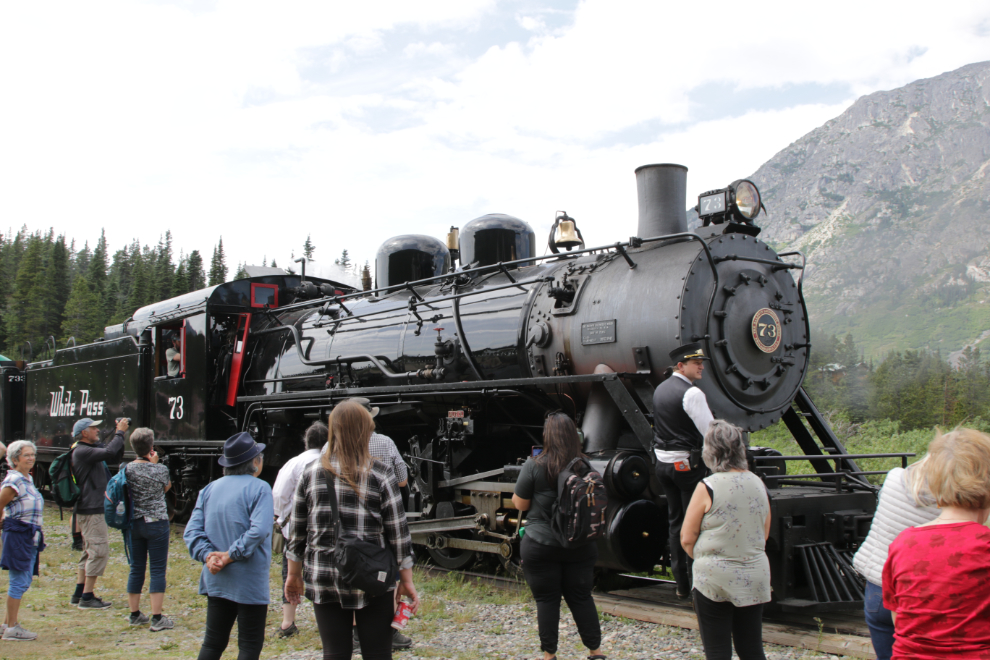
At 2:40 we re-boarded the train – in very orderly fashion 🙂 We got on the same car we came up on, and the request was made to sit on the opposite side so that everyone got the lake side views in one direction.
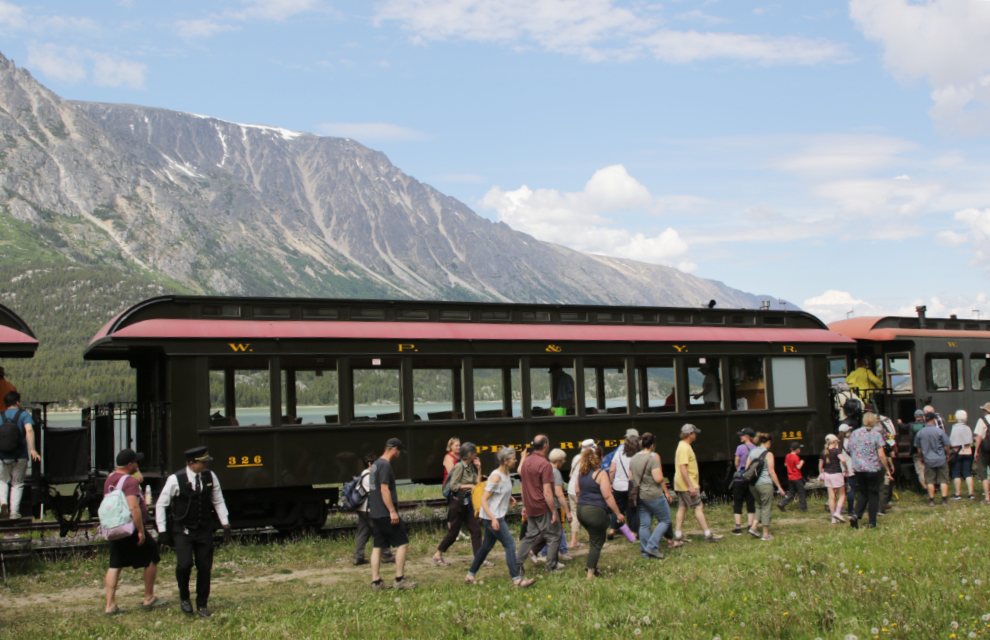
I stood on the outside platform about half the time, as I did on the way south. Surprisingly few people used the platforms – usually sharing the very limited space is needed but that was seldom the case on this trip.
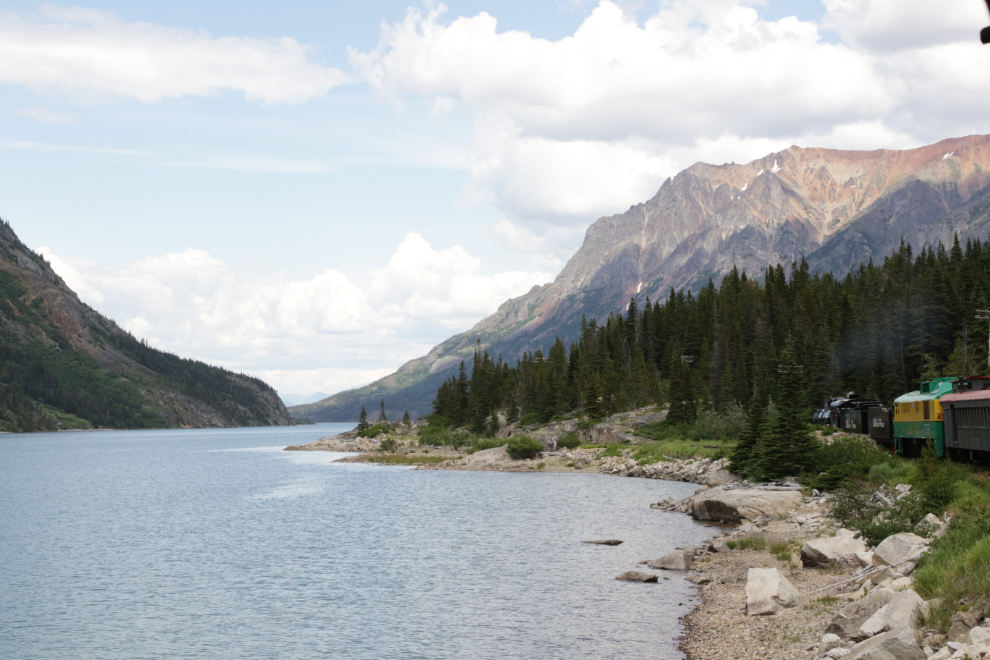
Wow, what a camping spot!
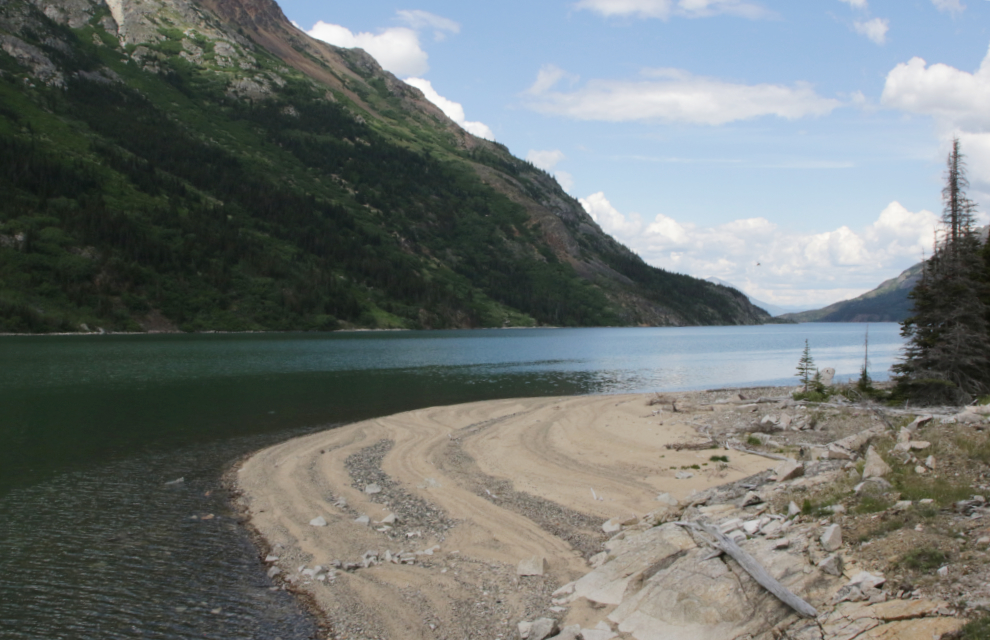
The light was seldom good for the photos I wanted to include the locomotives in.

Across the lake at about MP 47 is the remains of the Gridiron silver/gold mine – the dock is at the orange rock on the beach in the centre of the photo. the property was explored in 1901, then considerable development work was done in 1904. I’ve posted information about it from the provincial mining reports on my Mining at Lake Bennett page. I parked my canoe at the remains of the small dock and had a good look at the property in 2003.
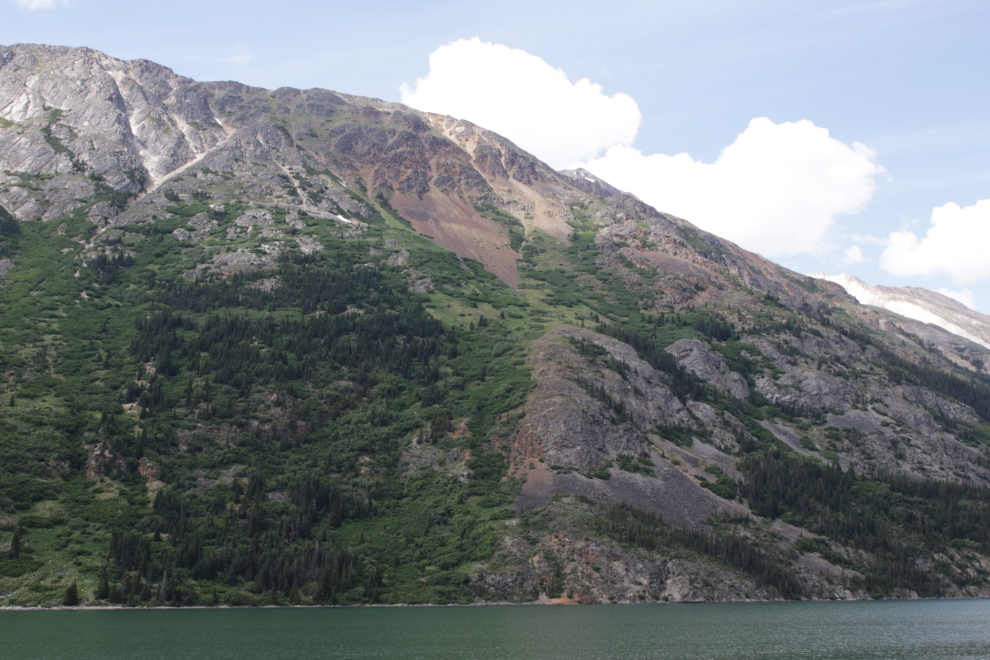
Imagine that mountain for helicopter-assisted hiking, just a few minutes from Carcross.
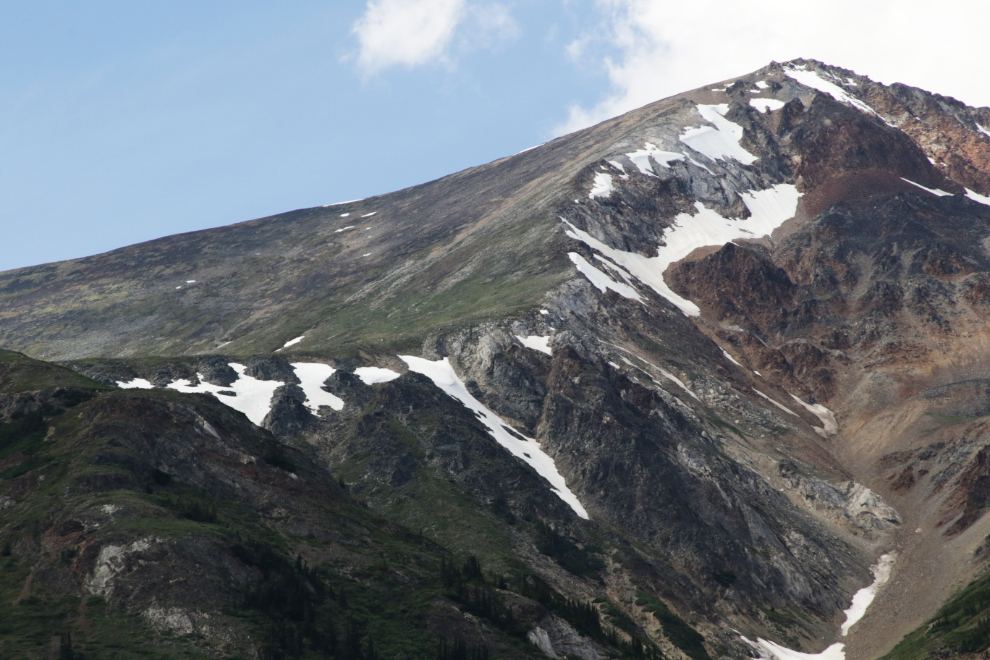
The view ahead just south of MP 49.
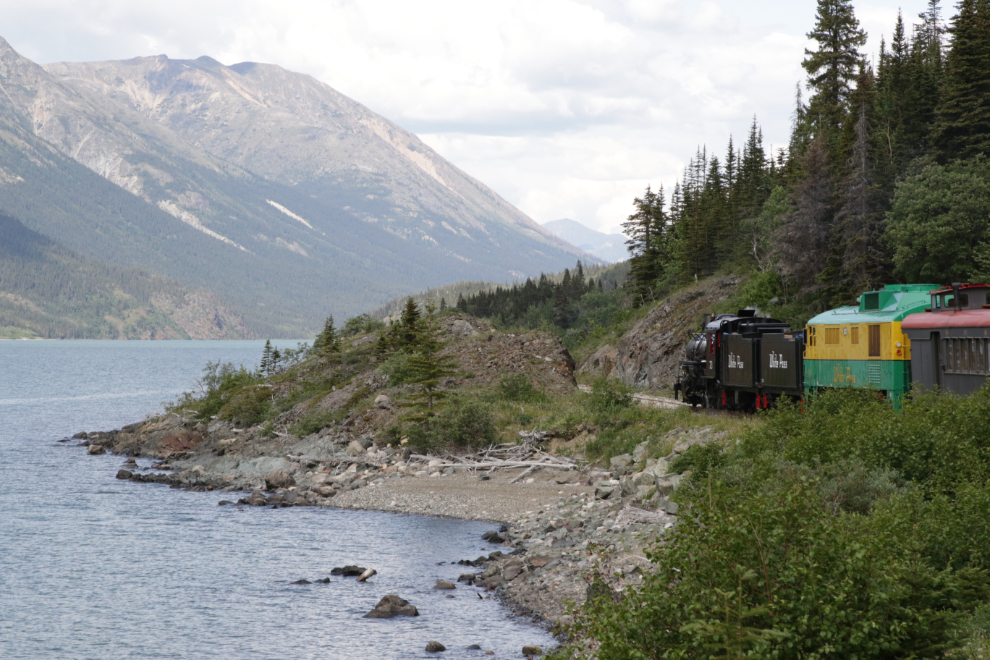
At 3:09 we pulled onto the siding at Scheffler to wait for the southbound regular. We stopped beside a peaceful little stream.
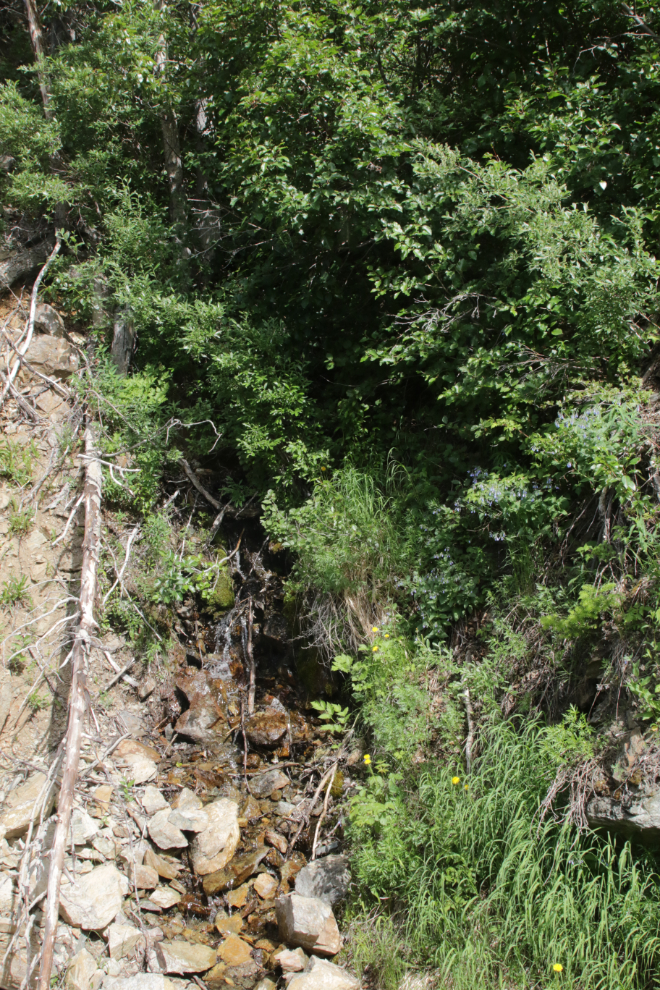
Butterflies and flowers had been abundant all along the lake. Here beside the creek were bluebells…
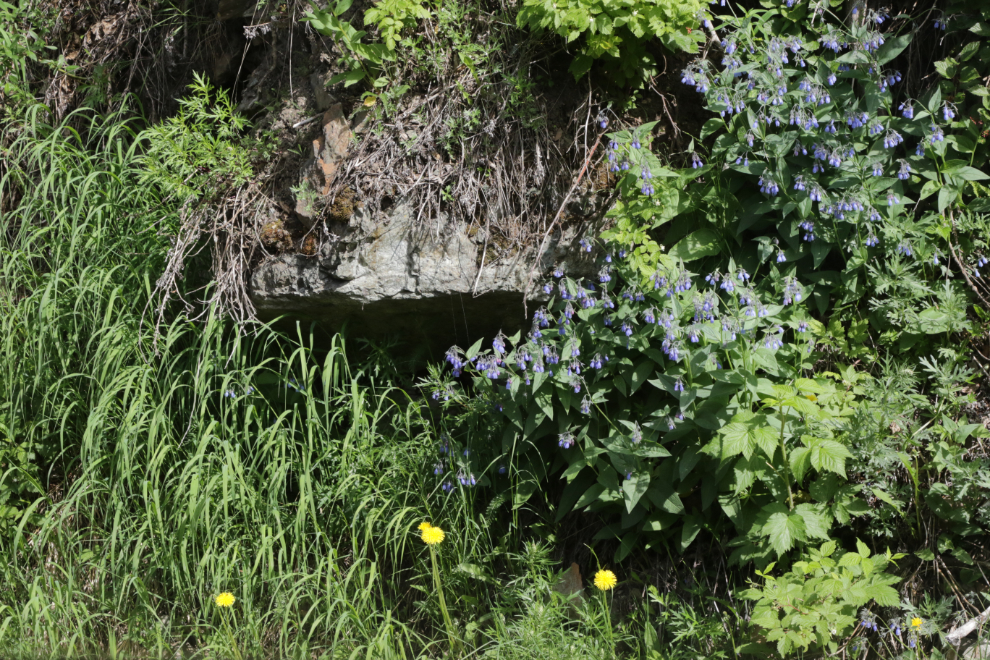
…and cow parsnip. We were getting to the edge of the solid cloud layer – it was nice to have the sun back.
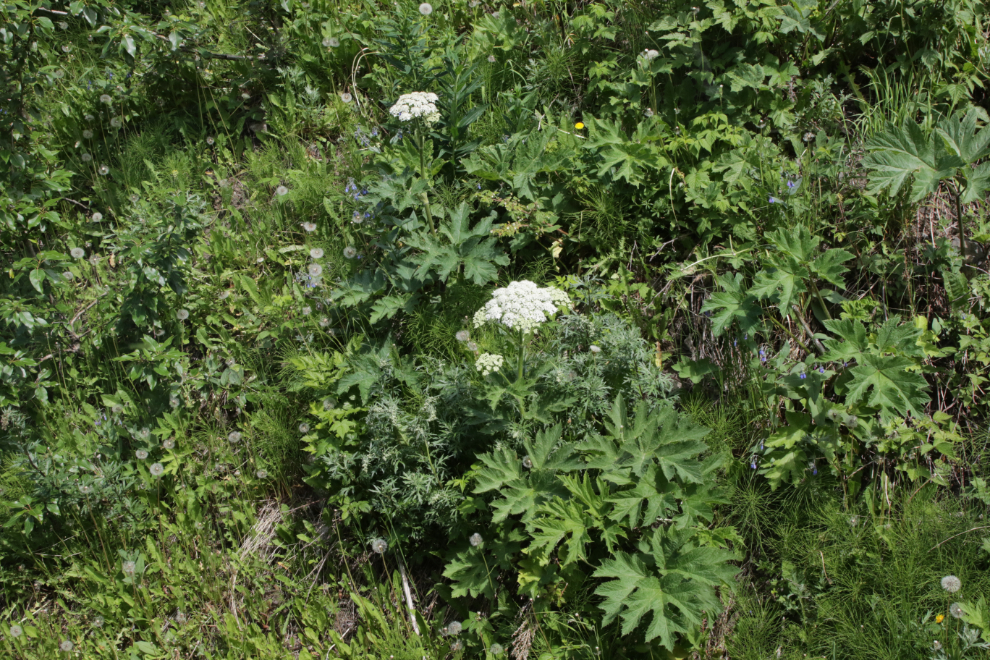
Just north of Pennington Station.
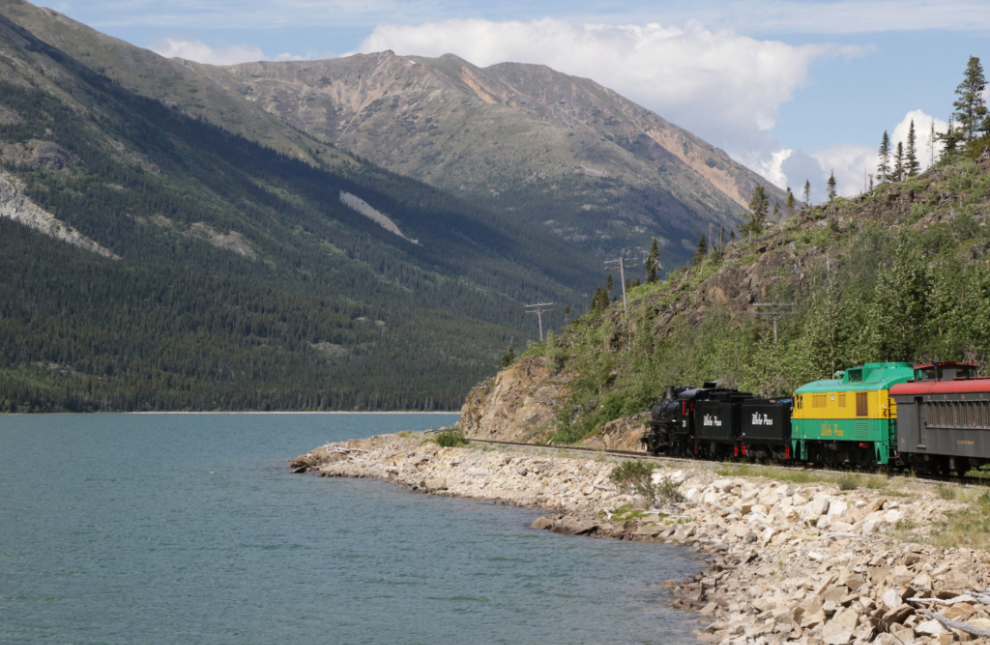
Just south of the BC-Yukon border.
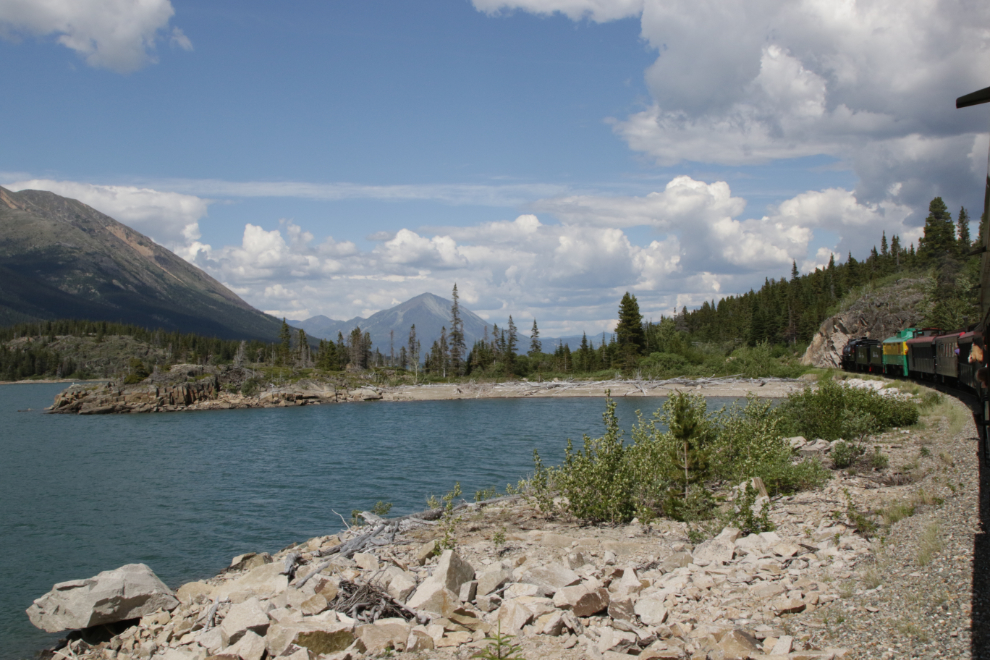
Welcome back to the Yukon, at 3:28.
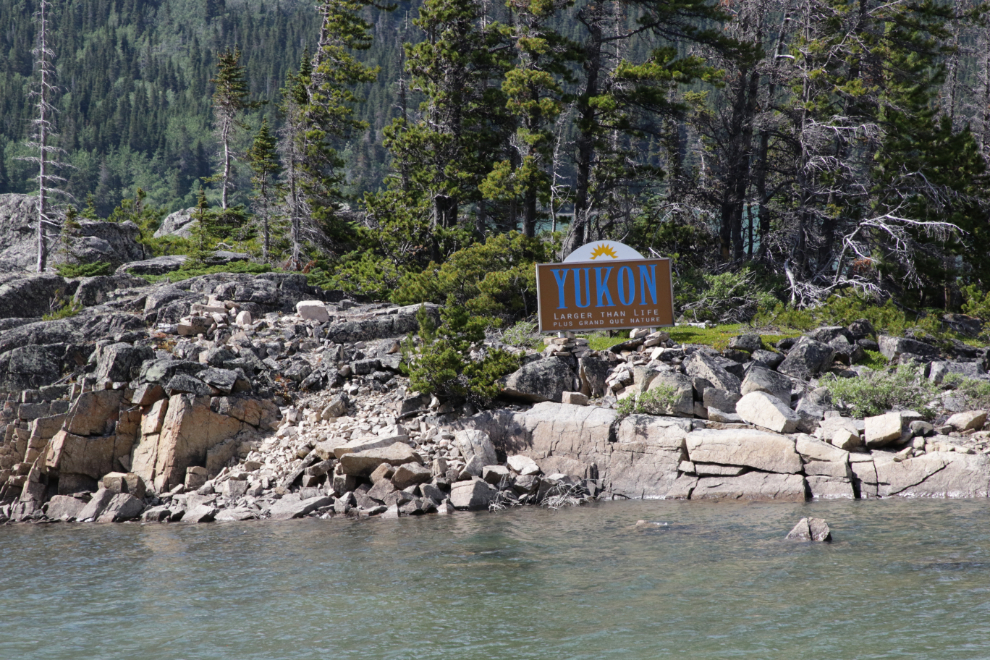
A closer look at the rocky knoll on Boundary Island where the Klondike graves are located. At low water a few weeks ago you could walk to the island.
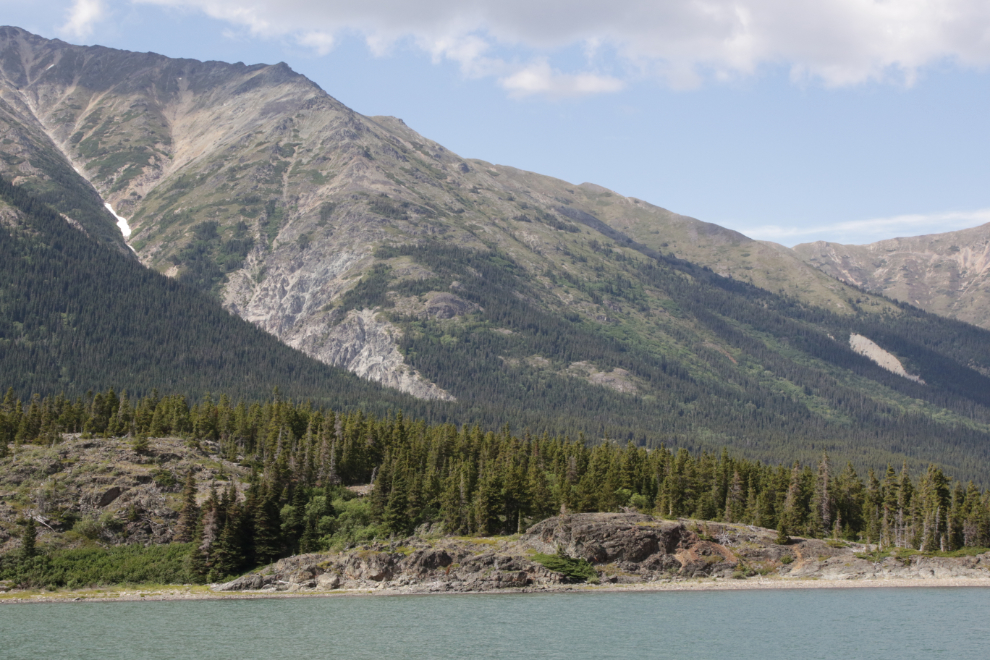
Back in Carcross at 4:14, 14 minutes late. The British Yukon Navigation dock is long past saving – the adjacent warehouse and the dock under it were restored perhaps 25 years ago, but although the warehouse was used as a craft market for a few years after the very expensive restoration, it hasn’t been used for many years.
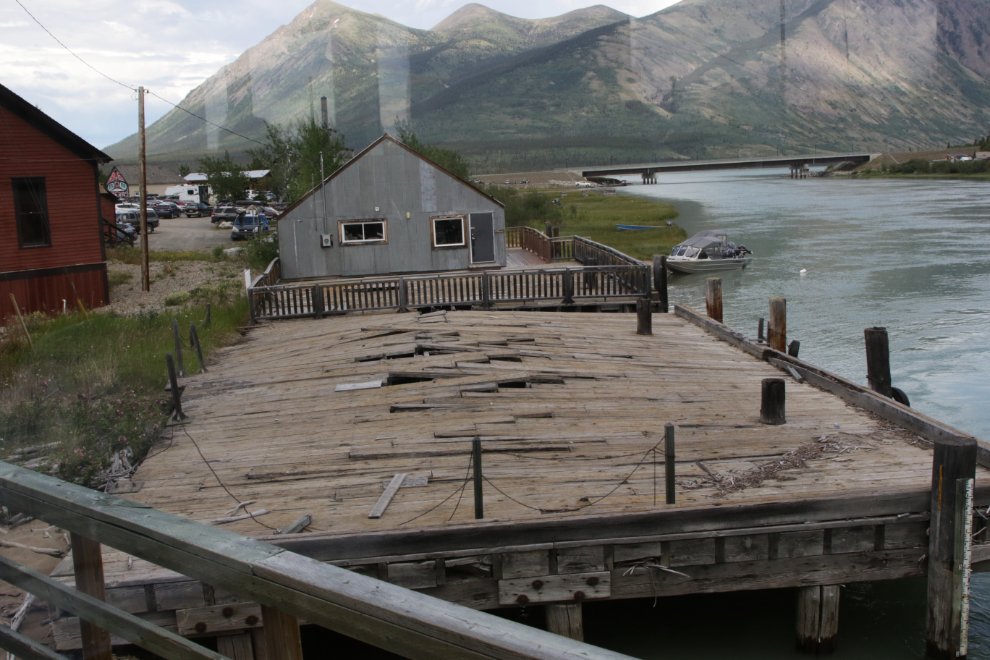
It feels like a very long time since Carcross has seen that many vehicles. A German couple I’ve been corresponding with for years spotted us as we were walking back to our car, and we spent a while chatting with them. Among other things, we finalized a time for them to stop in and visit us at home (that happened yesterday, on July 2nd).

There were some storms ahead as we started for home, but I was soon asleep and didn’t experience the heavy rain Cathy drove through.
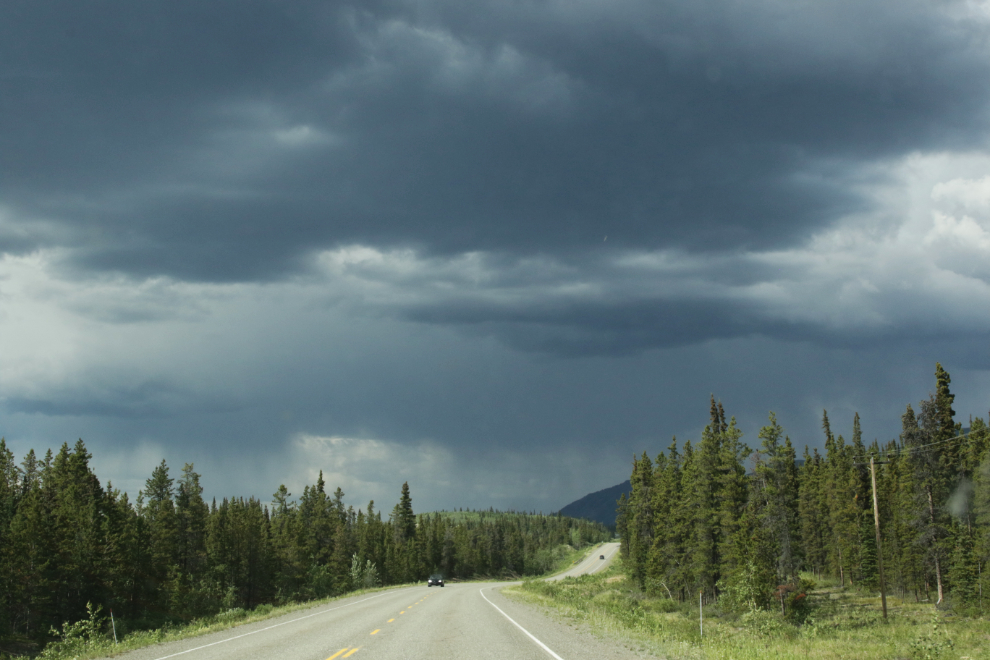
We had worked up serious hungers during the day, and this is what I put on my plate to finish off the day in style (then had another cob of corn!)

White Pass had presented each of us with a high-quality leather key fob, an excellent memento of the day.

I got rather carried away with this post – 79 photos! As I wrote this post, I came to realize that I may have moved on from Carcross, and perhaps even from Montana Mountain, but my love of Lake Bennett – my deep connection with it – hasn’t changed. That feels really good, and I hope you’ve enjoyed seeing it 🙂

Like many of your photo heavy posts – I came back for a more leisurely read and view (on a real Q monitor, not a laptop screen) and really enjoyed the photos a second time around… what a wonderful area to explore. Thanks for talking us through that great day.
It’s always really nice to hear that my photos deserve a second look on a larger screen 🙂 – I’m glad that you enjoyed the day.
FYI, the youtube video you mentioned about the almost traffic accident is listed as “private” when clicked.
Thanks for the reminder, Lee – it’s now Public.
Yes! Finally someone writes about naturism.
I wish more people could be open about their preferred lifestyle, without fear of bad attitudes.
Been there loved every minute ❤ on the train trip. That was in the early 1980. Thanks 4 all the pics.
Bruno Faccini
I’m pleased that you enjoyed it, Bruno – and that you experienced it back then.
This post perfectly captured the day, Murray! And filled in some gaps and answered some questions I had about it. Thank you, as always, for your wonderful posts!
Thank you very much, Sue 🙂